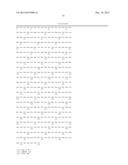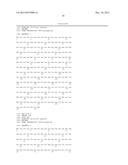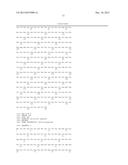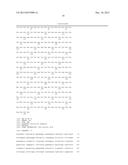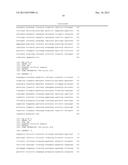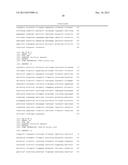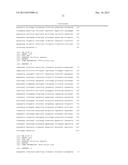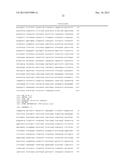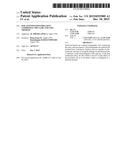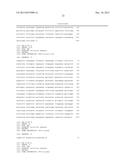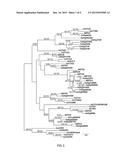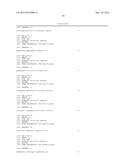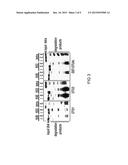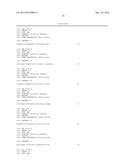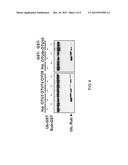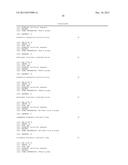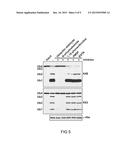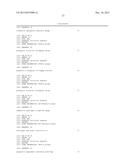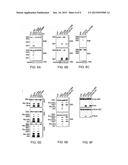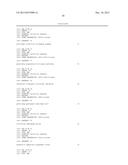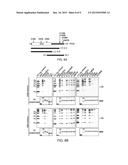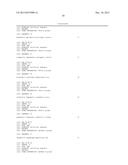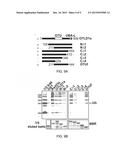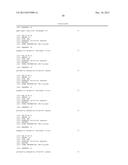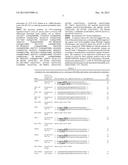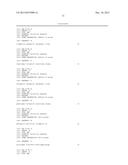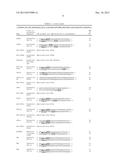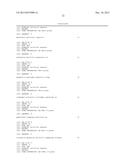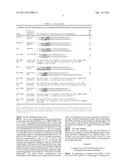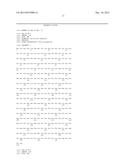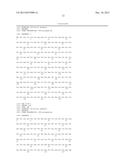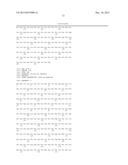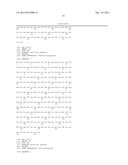Patent application title: ISOLATED POLYPEPTIDES, KITS COMPRISING THE SAME AND USES THEREOF
Inventors:
Hong-Yong Fu (Taipei, TW)
Ramalingam Radjacommare (Taipei, TW)
IPC8 Class: AC12N948FI
USPC Class:
435 681
Class name: Chemistry: molecular biology and microbiology micro-organism, tissue cell culture or enzyme using process to synthesize a desired chemical compound or composition enzymatic production of a protein or polypeptide (e.g., enzymatic hydrolysis, etc.)
Publication date: 2015-12-10
Patent application number: 20150353909
Abstract:
Disclosed herein are isolated polypeptides, kits comprising the same, and
uses thereof. The polypeptides are respectively isolated from Arabidopsis
thaliana and are capable of catalyzing the cleavage of a peptide linkage
located between the C-terminus of the distal ubiquitin (UB) and any of
the first methionine (M1), the 48th (K48) or the 63rd lysine
(K63) of the proximal UB in a UB chain, which is conjugated to a
substrate protein.Claims:
1. An isolated polypeptide capable of cleaving a peptide linkage located
between the C-terminus of the distal ubiquitin (UB) and any of the first
methionine (M1), the 48.sup.th (K48) or the 63.sup.rd lysine (K63) of the
proximal UB in a UB chain conjugated with a substrate protein,
comprising: an amino acid sequence at least 85% identical to any of SEQ
ID NO: 1, SEQ ID NO: 2, SEQ ID NO: 3, SEQ ID NO: 4, SEQ ID NO: 5, SEQ ID
NO: 6, SEQ ID NO: 7, SEQ ID NO: 8, or SEQ ID NO: 9.
2. The isolated polypeptide of claim 1, wherein the polypeptide is isolated from Arabidopsis thaliana (A. thaliana).
3. The isolated polypeptide of claim 2, wherein the isolated polypeptide has the amino acid sequence at least 85% identical to SEQ ID NO: 1, and mutations at amino acid residues 92, 89 and 288 of the isolated polypeptide abolish its activity to cleave the peptide linkage located between the C-terminus of the distal UB and the M1, K48, or K63 of the proximal UB in the UB chain.
4. The isolated polypeptide of claim 2, wherein the isolated polypeptide has the amino acid sequence at least 85% identical to SEQ ID NO: 4, and a mutation at amino acid residue 136 of the isolated polypeptide abolish its activity to cleave the peptide linkage located between the C-terminus of the distal UB and the K48 or K63 of proximal UB in the UB chain.
5. The isolated polypeptide of claim 4, wherein the isolated polypeptide has the amino acid sequence of SEQ ID NO: 5.
6. The isolated polypeptide of claim 2, wherein the isolated polypeptide has the amino acid sequence at least 85% identical to SEQ ID NO: 6, and a mutation at amino acid residue 48 of the isolated polypeptide abolish its activity to cleave the peptide linkage located between the C-terminus of the distal UB and the K48 or K63 of proximal UB in the UB chain.
7. The isolated polypeptide of claim 2, wherein the isolated polypeptide has the amino acid sequence at least 85% identical to SEQ ID NO: 8 or 9, and cleaves the peptide linkage located between the C-terminus of the distal UB and the K63 of proximal UB in the UB chain, at about pH 9 to 9.5.
8. The isolated polypeptide of claim 2, wherein the isolated polypeptide has the amino acid sequence at least 85% identical to any of SEQ ID NO: 1, SEQ ID NO: 3, SEQ ID NO: 4, SEQ ID NO: 6, SEQ ID NO: 8, or SEQ ID NO: 9; and is capable of cleaving the peptide linkage located between the C-terminus of the distal UB and the K48 or 63 of proximal ubiquitin in the UB chain at about pH 7 to 8.
9. The isolated polypeptide of claim 1, wherein the isolated polypeptide has the amino acid sequence at least 85% identical to SEQ ID NO: 2, and two mutations at amino acid residues 63 and 99, or 179 and 195 of the isolated polypeptide abolish its activity to bind ubiquitin.
10. A kit for cleaving a peptide linkage located between the C-terminus of the distal ubiquitin (UB) and any of the first methionine (M1), the 48.sup.th (K48) or the 63.sup.rd lysine (K63) of the proximal UB in a UB chain conjugated with a substrate protein, comprising: a container; at least one of the isolated polypeptide of claim 1; and a legend associated with the container and indicating how to use the at least one isolated polypeptide of claim 1 to direct the cleavage of the peptide linkage.
11. A method of deubiquitylation of a substrate protein having a conjugated UB chain, comprising: subjecting the substrate protein having the conjugated UB chain to the action of an isolated polypeptide having an amino acid sequence at least 85% identical to any of SEQ ID NO: 1, SEQ ID NO: 2, SEQ ID NO: 3, SEQ ID NO: 4, SEQ ID NO: 5, SEQ ID NO: 6, SEQ ID NO: 7, SEQ ID NO: 8, or SEQ ID NO: 9 for a sufficient period of time, so as to allow the cleavage of the peptide linkage located between the C-terminus of the distal ubiquitin (UB) and any of the first methionine (M1), the 48.sup.th (K48) or the 63.sup.rd lysine (K63) of the proximal UB in the conjugated UB chain.
12. The method of claim 11, wherein the polypeptide is isolated from Arabidopsis thaliana (A. thaliana).
13. The method of claim 12, wherein the isolated polypeptide has the amino acid sequence at least 85% identical to SEQ ID NO: 1, and mutations at amino acid residues 92, 89 and 288 of the isolated polypeptide abolish its activity to cleave the peptide linkage located between the C-terminus of the distal UB and the M1, K48, or K63 of the proximal UB in the conjugated UB chain.
14. The method of claim 12, wherein the isolated polypeptide has the amino acid sequence at least 85% identical to SEQ ID NO:, and a mutation at amino acid residue 136 of the isolated polypeptide abolish its activity to cleave the peptide linkage located between the C-terminus of the distal UB and the K48 or K63 of the proximal UB in the conjugated UB chain.
15. The method of claim 14, wherein the isolated polypeptide has the amino acid sequence of SEQ ID NO: 5.
16. The method of claim 12, wherein the isolated polypeptide has the amino acid sequence at least 85% identical to SEQ ID NO: 6, and a mutation at amino acid residue 48 of the isolated polypeptide abolish its activity to cleave the peptide linkage located between the C-terminus of the distal UB and the K48 or K63 of the proximal UB in the conjugated UB chain.
17. The method of claim 12, wherein the isolated polypeptide has the amino acid sequence at least 85% identical to SEQ ID NO: 8 or 9, and cleaves the peptide linkage located between the C-terminus of the distal UB and the K63 of the proximal UB in the conjugated UB chain at about pH 9 to 9.5.
18. The method of claim 12, wherein the isolated polypeptide has the amino acid sequence at least 85% identical to any of SEQ ID NO: 1, SEQ ID NO: 3, SEQ ID NO: 4, SEQ ID NO: 6, SEQ ID NO: 8, or SEQ ID NO: 9; and is capable of cleaving the peptide linkage located between the C-terminus of the distal UB and the K48 or 63 of proximal ubiquitin in the conjugated UB chain at about pH 7 to 8.
19. The method of claim 12, wherein the isolated polypeptide has the amino acid sequence at least 85% identical to SEQ ID NO: 2, and two mutations at amino acid residues 63 and 99, or 179 and 195 of the isolated polypeptide abolish its activity to bind ubiquitin.
Description:
BACKGROUND OF THE INVENTION
[0001] 1. Field of the Invention
[0002] The present disclosure in general relates to the field of peptidase activity, more particularly to the cleavage of a peptide linkage between ubiquitin and a substrate protein, i.e., deubiquitination.
[0003] 2. Description of Related Art
[0004] The function of a protein is regulated via various means in a cell; one way is via the conjugation and de-conjugation of a modifier protein ubiquitin (UB) to a target protein, e.g., ubiqutination or deubiquitination. The covalent modification of proteins by UB plays a central role in diverse cellular pathways such as cell cycle progression, signal transduction, transcriptional regulation, stress response, endocytosis, apoptosis and etc. Ubiquitination of a protein is catalyzed by a cascade of three enzymes. First, UB is activated by UB-activating enzyme (E1), which forms a thiol-ester bond with UB C-terminus. Then, UB is transferred to UB-conjugating enzyme (E2). Finally, UB C-terminus is ligated to the lysine residue of the target protein with the aid of UB ligases (E3). Target protein can be mono-ubiquitinated or multi-ubiquitinated by successive conjugation of UB C-terminus to the prior one through eight different linkages, which include M1, K6, K11, K27, K29, K33, K48 and K63 linkages.
[0005] While ubiqutination is important in diverse cellular pathways, the reverse reaction (i.e., deubiquitination), which is catalyzed by a diverse set of deubiquitination enzymes (DUBs), is equally important for modulating the ubiquitinated protein's activity and fate. The DUBs are proteases that specifically cleave the peptide bond between UBs or between UB C-terminus and covalently attached polypeptides. DUBs have been grouped into 5 classes, and 4 of these classes are cysteine proteases, including UB C-terminal hydrolases (UCHs), UB-specific processing (UBP) proteases, ovarian tumor (OTU)-related proteases and Josephin/Machado-Joseph disease (MJD) proteases. UBPs possess catalytic triad residues in highly conserved cysteine box and histidine box. UCHs have similar catalytic triad residues in two conserved cysteine and histidine boxes. As to OTUs, they also have a catalytic triad comparable to the other families in cysteine and histidine boxes.
[0006] In the model plant, Arabidopsis thaliana (A. thaliana), the function and biochemical properties of OTU DUBs have not yet been characterized. Inventors of this application unexpectedly identify 12 A. thaliana OTU loci and have analyzed the encoded proteins in vitro to determine their preferences for various types of UB chain linkages. Results of this study confirmed that 7 out of 12 proteins encoded from the identified A. thaliana OTU loci are active DUBs, and thus are useful in methods and/or kits involving deubiquitination of a substrate protein.
SUMMARY
[0007] The present disclosure is based, at least in part, unexpected discovery of 7 A. thaliana OTU proteins respectively possess DUB activity, hence are useful in methods and/or kits involving deubiquitination of a substrate protein.
[0008] Accordingly, it is the first aspect of this disclosure to provide an isolated A. thaliana polypeptide or a homologue thereof capable of cleaving a peptide linkage between the C-terminus of the distal UB and any of the first methionine (M1), the 48th (K48) or the 63rd lysine (K63) of the proximal UB in a UB chain conjugated with a protein. The isolated polypeptide comprises an amino acid sequence at least 85% identical to any of SEQ ID NO: 1 (OTU1, Gene Bank Access NO: JQ013442), SEQ ID NO: 2 (OTU2, Gene Bank Access NO: JQ013443), SEQ ID NO: 3 (OTU3, Gene Bank Access NO: JQ013444), SEQ ID NO: 4 (OTU4c, Gene Bank Access NO: JQ013446), SEQ ID NO: 5 (OTU4c-NΔ, Gene Bank Access NO: JQ013446), SEQ ID NO: 6 (OTU7a, Gene Bank Access NO: JQ013452), SEQ ID NO: 7 (OTU7b, Gene Bank Access NO: JQ013453), SEQ ID NO: 8 (OTU9, Gene Bank Access NO: JQ013455), or SEQ ID NO: 9 (OTU10, Gene Bank Access NO: JQ013456).
[0009] In one example, the isolated polypeptide has the amino acid sequence at least 85% identical to SEQ ID NO: 1, and mutations at amino acid residues 92, 89 and 288 of the isolated polypeptide abolish its activity to cleave the peptide linkage located between the C-terminus of the distal UB and the M1, K48, or K63 of the proximal UB in the UB chain.
[0010] In another example, the isolated polypeptide has the amino acid sequence at least 85% identical to SEQ ID NO: 4, and a mutation at amino acid residue 136 of the isolated polypeptide abolish its activity to cleave the peptide linkage located between the C-terminus of the distal UB and the K48 or K63 of the proximal UB in the UB chain. In one preferred example, the isolated polypeptide has the amino acid sequence identical to SEQ ID NO: 5.
[0011] In still another example, the isolated polypeptide has the amino acid sequence at least 85% identical to SEQ ID NO: 6, and a mutation at amino acid residue 48 of the isolated polypeptide abolish its activity to cleave the peptide linkage located between the C-terminus of the distal UB and the K48 or K63 of the proximal UB in the UB chain.
[0012] In a further example, the isolated polypeptide has the amino acid sequence at least 85% identical to SEQ ID NO: 8 or 9, and cleaves the peptide linkage located between the C-terminus of the distal UB and the K63 of the proximal UB in the UB chain at about pH 9 to 9.5.
[0013] According to some embodiments of the present disclosure, the isolated polypeptide has the amino acid sequence at least 85% identical to SEQ ID NO: 1 (OTU1), SEQ ID NO: 3 (OTU3), SEQ ID NO: 4 (OTU4c), SEQ ID NO: 6 (OTU7a), SEQ ID NO: 8 (OTU9), or SEQ ID NO: 9 (OTU10); and is capable of cleaving the peptide linkage located between the C-terminus of the distal UB and the K48 or 63 of the proximal UB in the UB chain at about pH 7 to 8. In other embodiments, the isolated polypeptide has the amino acid sequence at least 85% identical to SEQ ID NO: 2, and two mutations at amino acid residues 63 and 99, or 179 and 195 of the isolated polypeptide abolish its activity to bind ubiquitin.
[0014] It is the second aspect of this disclosure to provide a kit for cleaving a peptide linkage located between the C-terminus of the distal UB and any of the first methionine (M1), the 48th (K48) or the 63rd lysine (K63) of the proximal UB in a UB chain, which is conjugated with a substrate protein. The kit includes a container; at least one isolated polypeptide of the present disclosure; and a legend associated with the container and indicating how to use the isolated polypeptide to direct the cleavage of the afore-mentioned peptide linkage.
[0015] According to embodiments of the present disclosure, the substrate protein may be any protein modified with ubiquitin and/or its fragment; and the peptide linkage is located between the C-terminus of the distal ubiquitin (UB) and any of the first methionine (M1), the 48th (K48) or the 63rd lysine (K63) of the proximal UB in the UB chain; and the isolated polypeptide has an amino acid sequence at least 85% identical to any of SEQ ID NO: 1, SEQ ID NO: 2, SEQ ID NO: 3, SEQ ID NO: 4, SEQ ID NO: 5, SEQ ID NO: 6, SEQ ID NO: 7, SEQ ID NO: 8, or SEQ ID NO: 9.
[0016] It is therefore the third aspect of this disclosure to provide a method of deubiquitinating a substrate protein. The method includes the step of subjecting the substrate protein having a conjugated UB chain to the action of an isolated polypeptide of the present disclosure for a sufficient period of time, so as to allow the cleavage of the peptide linkage between the C-terminus of the distal ubiquitin (UB) and any of the first methionine (M1), the 48th (K48) or the 63rd lysine (K63) of the proximal UB in the UB chain, wherein the isolated polypeptide has an amino acid sequence at least 85% identical to any of SEQ ID NO: 1, SEQ ID NO: 2, SEQ ID NO: 3, SEQ ID NO: 4, SEQ ID NO: 5, SEQ ID NO: 6, SEQ ID NO: 7, SEQ ID NO: 8, or SEQ ID NO: 9.
[0017] The details of one or more embodiments of this disclosure are set forth in the accompanying description below. Other features and advantages of the invention will be apparent from the detail descriptions, and from claims.
[0018] It is to be understood that both the foregoing general description and the following detailed description are by examples, and are intended to provide further explanation of the invention as claimed.
BRIEF DESCRIPTION OF THE DRAWINGS
[0019] The accompanying drawings, which are incorporated in and constitute a part of the specification, illustrate various example systems, methods and other exemplified embodiments of various aspects of the invention. The present description will be better understood from the following detailed description read in light of the accompanying drawings, where,
[0020] FIG. 1 is a schematic diagram illustrating the phylogenetic tree of the OTU-proteins from A. thaliana, O. sativa, S. cerevisiae, and H. sapiens in accordance with one embodiment of the present disclosure;
[0021] FIG. 2 illustrates the A. thaliana OTU-containing proteins display distinctive preference for K48- and K63-linked UB tetramers in accordance with one embodiment of the present disclosure;
[0022] FIG. 3 illustrates the relative cleavage activities of A. thaliana OTU1, OTU3, and OTU4c against linear (tetra) and K48- or K63-linked UB tetramers in accordance with one embodiment of the present disclosure;
[0023] FIG. 4 illustrates the relative cleavage activities of A. thaliana OTU3, OTU4c, OTU7a, OTU9, and OTU10 for UB- and RUB-fused GST in accordance with one embodiment of the present disclosure;
[0024] FIG. 5 illustrates the inhibition of A. thaliana OTU1 by cysteine protease inhibitors in accordance with one embodiment of the present disclosure;
[0025] FIGS. 6A-6F illustrate the requirement of the conserved catalytic triad for the deubiquitylation activities of A. thaliana OTU1, OTU4c and OTU7a in accordance with one embodiment of the present disclosure;
[0026] FIGS. 7A-7B illustrate the association of A. thaliana OTU2 and OTLD1 with isopeptide bond-linked UB chains and their preference for different linkage types in accordance with one embodiment of the present disclosure;
[0027] FIG. 8A is a schematic diagram illustrating the site-specific and deletion variants of OTU2 that were used to delineate the domains and residues involved in UB-binding in according to one embodiment of the present invention;
[0028] FIG. 8B illustrates the UB-binding activities of A. thaliana OTU2 N- and C-terminal variants of FIG. 8A;
[0029] FIG. 9A is a schematic diagram illustrating the deletion variants of OTLD1 that were used to delineate the domains and residues involved in UB-binding in according to one embodiment of the present invention;
[0030] FIG. 9B illustrates the relative UB-binding activities of A. thaliana OTLD1 N- and C-terminal variants of FIG. 9A in according to one embodiment of the present invention;
DETAILED DESCRIPTION OF THE PREFERRED EMBODIMENTS
[0031] The detailed description provided below in connection with the appended drawings is intended as a description of the present disclosure and is not intended to represent the only forms in which the present disclosure may be constructed or utilized.
DEFINITIONS
[0032] The terms "polypeptide" and "protein" are used interchangeably herein and refer to amino acids in a polymeric form of any length, linked together by peptide bonds.
[0033] The term "nucleic acid(s)" and "polynucleotide(s)" are used interchangeably herein to mean nucleotides, either ribonucleotides or deoxyribonucleotides or a combination of both, in a polymeric unbranched form of any length.
[0034] The term "identical" or "percent (%) identity" as used herein refers to two or more sequences or subsequences that are the same or have a specified percentage of amino acid residues or nucleotides that are the same, when compared and aligned for maximum correspondence. To determine the percent identity, the sequences are aligned for optimal comparison purposes (e.g., gaps can be introduced in the sequence of a first amino acid sequence for optimal alignment with a second amino acid sequence). The amino acid residues or nucleotides at corresponding positions are then compared. When a position in the first sequence is occupied by the same amino acid residue or nucleotide as the corresponding position in the second sequence, then the molecules are identical at that position. The percent identity between the two sequences is a function of the number of identical positions shared by the sequences (i.e., % identity=number of identical positions/total number of positions (e.g., overlapping positions)×100). In certain embodiments, the two sequences are the same length. Methods for alignment of sequences for comparison are well known in the art, such methods include GAP, BESTFIT, BLAST, FASTA and TFASTA.
[0035] The term "ubiquitin (UB)" as used herein is interpreted broadly to encompass the full length UB (i.e., 76 amino acids in length) and its fragment, as long as it is active as a substrate for isopeptidase (e.g., the isolated polypeptide of the present disclosure). Preferably, the UB fragment in the present disclosure comprises at least 25%, 30%, 40%, 50%, 60%, 70%, 75%, 80%, 85%, or more particularly, 90%, 95%, 97%, 99% or more of the full length UB. Throughout this specification, the term "a UB chain" refers to a UB polymer composed of at least 3, 4, 5, 6, 7, 8, 9, 10, 11, 12, 13, 14, 15, 16, 17, 18, 19, or 20 units of UBs; preferably at least 5, 6, 7, 8, 9, 10, 11, 12, 13, 14, 15, 16, 17, 18, 19, or 20 units of UBs. When the distal or proximal UB is used, it is in relative to its proximity to a substrate protein, for example, the distal UB refers to the UB of a UB chain that is away from the substrate protein, whereas the proximal UB refers to the UB of a UB chain that is close to the substrate protein (see Komander and Rape, (2012) Annu. Rev. Biochem. 81, 203-229).
[0036] The term "plant" as used herein encompasses whole plants, ancestors and progeny of the plants and plant parts, including seeds, shoots, stems, leaves, roots, flowers, tissues and organs. The term "plant" also encompasses plant cells, suspension cultures, callus tissue, embryos, meristematic regions, gametophytes, sporophytes, pollen and microspores.
[0037] The singular forms "a", "and", and "the" are used herein to include plural referents unless the context clearly dictates otherwise.
[0038] Notwithstanding that the numerical ranges and parameters setting forth the broad scope of the invention are approximations, the numerical values set forth in the specific examples are reported as precisely as possible. Any numerical value, however, inherently contains certain errors necessarily resulting from the standard deviation found in the respective testing measurements. Also, as used herein, the term "about" generally means within 10%, 5%, 1%, or 0.5% of a given value or range. Alternatively, the term "about" means within an acceptable standard error of the mean when considered by one of ordinary skill in the art. Other than in the operating/working examples, or unless otherwise expressly specified, all of the numerical ranges, amounts, values and percentages such as those for quantities of materials, durations of times, temperatures, operating conditions, ratios of amounts, and the likes thereof disclosed herein should be understood as modified in all instances by the term "about." Accordingly, unless indicated to the contrary, the numerical parameters set forth in the present disclosure and attached claims are approximations that can vary as desired. At the very least, each numerical parameter should at least be construed in light of the number of reported significant digits and by applying ordinary rounding techniques.
[0039] The present disclosure is based, at least in part, unexpected discovery of several novel ovarian tumor (OTU) domain containing polypeptides identified and isolated from A. thaliana respectively possess deubiquitination (DUB) activity in vitro; hence these novel isolated OTU DUBs and fragments thereof are useful in methods and/or kits involving deubiquitination of a substrate protein.
[0040] Identifying Novel A. thaliana Polypeptide with Isopeptidase Activity
[0041] Accordingly, one aspect of the present disclosure is to provide novel polypeptides and/or fragments thereof isolated from A. thaliana. Each of the isolated polypeptide comprises an amino acid sequence at least 85% identical to any of SEQ ID NOs: 1 to 9; which is coded by a nucleic acid at least 90% identical to any of SEQ ID NOs: 10 to 18.
[0042] The novel isolated polypeptides and/or fragments thereof of the present disclosure typically possess at least 70%, 71%, 72%, 73%, 74%, 75%, 76%, 77%, 78%, 79%, 80%, 81%, 82%, 83%, 84%, 85%, 86%, 87%, 88%, 89%, 90%, 91%, 92%, 93%, 94%, 95%, 96%, 97%, 98%, 99% or 100% sequence identity to any of SEQ ID NO: 1 to 9 from A. thaliana. Preferably, the novel isolated polypeptides and/or fragments thereof of the present disclosure typically possess at least 85%, 86%, 87%, 88%, 89%, 90%, 91%, 92%, 93%, 94%, 95%, 96%, 97%, 98%, 99% or 100% sequence identity to any of SEQ ID NO: 1 to 9 from A. thaliana.
[0043] According to embodiments of the present disclosure, each of the isolated polypeptide and/or fragments thereof possesses deubiquitination (DUB) activity in vitro, meaning it is capable of cleaving a peptide linkage, particularly an isopeptide linkage between two UBs, such as the isopeptide located between the C-terminus of the distal UB and any of the first methionine (M1), the 48th (K48) or the 63rd lysine (K63) of the proximal UB in a UB chain, in which the UB chain may be optionally conjugated with a substrate protein.
[0044] Nucleic acids encoding the isolated polypeptides and/or fragments thereof of the present disclosure are represented by polynucleotide sequences that is any of SEQ ID NO: 10 to 18. Nucleic acids encoding the isolated polypeptides and/or fragments thereof of the present disclosure need not to be the full length nucleic acids. According to some embodiments of the present disclosure, a portion of any of the SEQ ID NO: 10 to 18 or a nucleic acid at least 90%, 91%, 92%, 93%, 94%, 95%, 96%, 97%, 98%, 99% or 100% identical to SEQ ID NO: 10 to 18, capable of expressing an amino acid sequence at least 85% identical to any of SEQ ID NO: 1 to 9, is sufficient to carry out the present invention. A portion of nucleic acid may be prepared by making one or more deletion to the nucleic acid, which may be used in its isolated form to produce the isolated polypeptides and/or fragments thereof of the present disclosure. Furthermore, nucleic acid variants may also be obtained by site-directed mutagenesis. Several methods are available for site-directed mutagenesis, in which PCR-based method is the most commonly adopted one.
[0045] In one example, the isolated polypeptide has the amino acid sequence of SEQ ID NO: 1, which is encoded by the nucleic acid of SEQ ID NO: 10; and mutations at amino acid residues 92, 89 and 288 of this isolated polypeptide abolish its activity to cleave the peptide linkage between the C-terminus of the distal UB and the M1, K48, or K63 of the proximal UB of the UB chain.
[0046] In other embodiments, the isolated polypeptide has the amino acid sequence of SEQ ID NO: 2, which is encoded by a nucleic acid of SEQ ID NO: 11, and two mutations at amino acid residues 63 and 99, or 179 and 195 of the isolated polypeptide, abolish its activity to bind ubiquitin.
[0047] In another example, the isolated polypeptide has the amino acid sequence of SEQ ID NO: 4, which is encoded by the nucleic acid of SEQ ID NO: 13, and a mutation at amino acid residue 136 of this isolated polypeptide abolish its activity to cleave the peptide linkage between the C-terminus of the distal UB and K48 or K63 of the proximal UB in the UB chain. In one preferred example, the isolated polypeptide has the amino acid sequence of SEQ ID NO: 5, which is encoded by the nucleic acid of SEQ ID NO: 14.
[0048] In still another example, the isolated polypeptide has the amino acid sequence of SEQ ID NO: 6, which is encoded by the nucleic acid of SEQ ID NO: 15, and a mutation at amino acid residue 48 of this isolated polypeptide abolish its activity to cleave the peptide linkage located between the C-terminus of the distal UB and K48 or K63 of the proximal UB in the UB chain.
[0049] In a further example, the isolated polypeptide has the amino acid sequence of SEQ ID NO: 8 or 9, which is encoded by the nucleic acid of SEQ ID NO: 17 or 18, and this isolated polypeptide is capable of cleaving the peptide linkage between the C-terminus of the distal UB and K63 of the proximal UB in the UB chain, at about pH 9 to 9.5.
[0050] According to some embodiments of the present disclosure, the isolated polypeptide has the amino acid sequence of any of SEQ ID NO: 1, SEQ ID NO: 3, SEQ ID NO: 4, SEQ ID NO: 6, SEQ ID NO: 8, or SEQ ID NO: 9; and is capable of cleaving the peptide linkage between the C-terminus of the distal UB and K48 or 63 of the proximal UB in the UB chain, at about pH 7 to 8.
[0051] Methods and Kits for Deubiquitinizing A Substrate Protein
[0052] The afore-identified and isolated A. thaliana polypeptides and/or fragments thereof may be packaged into kits for deubiquitinating a substrate protein.
[0053] In some embodiments, the kits comprise at least one of the isolated A. thaliana polypeptides and/or fragments thereof described above. The kits may optionally comprise one or more isopeptidase or deubiquitinase that is different from the isolated A. thaliana polypeptides and/or fragments thereof of the present disclosure; and instructions that explain how to conduct the deubiqutination assay. Other optional reagents in the kit may include appropriate buffer solutions for performing isopeptidase reaction. As used herein, "instruction" includes a publication, a recording, a diagram, or any other medium of expression that can be used to communicate or teach the user how to perform a method of the present invention. The instruction can be affixed to a container, which contains a kit of the invention. Alternatively, the instruction is packed independently from the container that comprises the kit of the invention.
[0054] It is therefore a further aspect of the present disclosure to provide a method of deubiquitinating a substrate protein by use of the kit of the present disclosure.
[0055] The substrate protein may be any protein modified with at least one UB and/or its fragment. The substrate protein may be isolated from a biological sample, which includes, but is not limited to, a plant sample, and an animal sample. In one preferred embodiment, the biological sample suitable for use in the present method is a plant sample, which includes, but is not limited to, a plant tissue sample, a plant cell sample, and a biological plant fluid sample.
[0056] The method includes the step of, subjecting the substrate protein having a conjugated UB chain to the action of the isolated polypeptide and/or fragment thereof of the present disclosure for a sufficient period of time, so as to allow the cleavage of the peptide linkage between the C-terminus of the distal UB and any of the first methionine (M1), the 48th (K48) or the 63rd lysine (K63) of the proximal UB in the UB chain, wherein the isolated polypeptide has an amino acid sequence at least 85% identical to any of SEQ ID NO: 1, SEQ ID NO: 2, SEQ ID NO: 3, SEQ ID NO: 4, SEQ ID NO: 5, SEQ ID NO: 6, SEQ ID NO: 7, SEQ ID NO: 8, or SEQ ID NO: 9.
[0057] In one example, the method includes the step of incubating the substrate protein with an isolated polypeptide having an amino acid sequence at least 85% identical to SEQ ID NO: 1 for a sufficient period of time, until the isopeptide linkage between the C-terminus of the distal UB and the M1, K48, or K63 of the proximal UB in the UB chain is cleaved.
[0058] In another example, the method includes the step of incubating the substrate protein with an isolated polypeptide having an amino acid sequence at least 85% identical to SEQ ID NO: 5 for a sufficient period of time, until the peptide linkage between the C-terminus of the distal UB and the K48 or K63 of the proximal UB in the UB chain is cleaved.
[0059] In still another example, the method includes the step of incubating the substrate protein with an isolated polypeptide having an amino acid sequence at least 90% identical to SEQ ID NO: 6, for a sufficient period of time, until the peptide linkage between the C-terminus of the distal UB and the K48 or K63 of the proximal UB in the UB chain is cleaved.
[0060] In a further example, the method includes the step of incubating the substrate protein with an isolated polypeptide having an amino acid sequence at least 90% identical to SEQ ID NO: 8 or 9, for a sufficient period of time, until the isopeptide linkage between the C-terminus of the distal UB and the K48 or K63 of the proximal UB in the UB chain is cleaved, which occurs at about pH 9 to 9.5.
[0061] According to some embodiments of the present disclosure, the method includes the step of incubating the substrate protein having a UB chain conjugated thereto with an isolated polypeptide having an amino acid sequence at least 85% identical to any of SEQ ID NO: 1 (OTU1), SEQ ID NO: 3 (OTU3), SEQ ID NO: 4 (OTU4c), SEQ ID NO: 6 (OTU7a), SEQ ID NO: 8 (OTU9), or SEQ ID NO: 9 (OTU10), for a sufficient period of time, until the isopeptide linkage between the C-terminus of the distal UB and K48 or K63 of the proximal UB in the UB chain is cleaved, which occurs at about pH 7 to 8.
[0062] In other embodiments, the method includes the step of incubating the isolated polypeptide having the amino acid sequence at least 85% identical to SEQ ID NO: 2, for a sufficient period of time, until the isopeptide linkage between the C-terminus of the distal UB and the K48 or K63 of the proximal UB in the UB chain is cleaved.
[0063] The present invention will now be described more specifically with reference to the following embodiments, which are provided for the purpose of demonstration rather than limitation. While they are typically of those that might be used, other procedures, methodologies, or techniques known to those skilled in the art may alternatively be used.
EXAMPLES
Materials and Methods
[0064] Bioinformatics
[0065] The A. thaliana and O. sativa OTU loci were identified by reiterative searches of the databases respectively maintained by Arabidopsis Information Resource (TAIR) (Phoenix Bioinformatics, Redwood City, Calif., U.S.A.) and National Center for Biotechnology Information (NCBI) (Bethesda, Md., USA) using the H. sapiens OTUB1 and OTUB2 and S. cerevisiae Otu1 sequences as initial queries. Protein domains were identified with SMART from the ExPASy server. Routine DNA and protein sequence analyses were conducted with GCG Version 11.1.3-UNIX (Accelrys Inc.).
[0066] To generate the phylogenetic tree, the OTU domain sequences were aligned using MUSCLE with the default settings. The resulting alignment was used to infer the phylogeny by using maximum likelihood and Bayesian methods. We used the PhyML program for the maximum likelihood method (Guindon and Gascuel, (2003) Syst. Biol. 52, 696-704.). To estimate the level of support for each internal branch, we generated 1,000 non-parametric bootstrap samples of the alignment by using the SEQBOOT program from the PHYLIP package (Felsenstein, (1989) Cladistics 5, 164-166.) and repeated the phylogenetic inference as described above. For the Bayesian approach, we used the program MrBayes (Ronquist and Huelsenbeck, (2003) Bioinformatics 19, 1572-1574; Altekar et al., (2004) Bioinformatics 20, 407-415.) to infer the posterior probability distributions.
[0067] The accession numbers for OTU-containing sequences from O. sativa, H. sapiens, and S. cerevisiae with abbreviated binominal name prefixes are as follows: AK120577 (Os01g0900900), EAY84610 (Os02g06890), BAD38558 (Os02g31830), BAD26139 (Os02g32180), EEC73285 (Os02g32190), BAD26147 (Os02g32280), AK067291 (Os02g0168600), NP--001046946 (Os02g0513800), AK119352 (Os02g0819500), NP--001049654 (Os03g0266000), AK072986 (Os03g0589300), AK071971 (Os03g0859800), AK240901 (Os04g32970), AK101471 (Os04g0414100), AK066247 (Os04g0619500), AK107489 (Os04g0652600), AK103099 (Os04g0670400), AK073551 (Os06g0669800), EEE69074 (Os08g42540), NP--001062186 (Os08g0506000), NP--001063527 (Os09g0487700), Q9NP73 (HsALG13), NP--060140 (HsOTUB1), NP--075601 (HsOTUB2), NP--001138845 (HsOTUD1), Q5T2D3 (HsOTUD3), EAX05048 (HsOTUD4), NP--060072 (HsOTUD5), Q7L8S5 (HsOTUD6A), AAH29760 (HsOTUD6B), NP--570971 (HsOTUD7A), NP--064590 (HsOTUD7B), Q96BN8 (HsOTULIN/FAM105B), NP--006281 (HsTNFAIP3/A20), NP--079330 (HsVCPIP1), NP--061036 (HsYOD1), CAB64449 (HsZRANB1), P43558 (ScOTU1), and P38747 (ScOTU2).
[0068] Recombinant OTU Protein Purification
[0069] To express various His- and GST-tagged OTU proteins of the present disclosure, corresponding full-length coding regions were PCR-amplified using PfuTurbo (Agilent Technologies) and cloned in frame into pET28 or pET42 vectors, respectively (EMD Millipore). Specific primers for cloning the OTU proteins, their site-specific variants are listed in Table 1. Mutagenesis was performed with PfuTurbo according to manufacturer's instructions (Agilent Technologies). The sequences of all expression constructions were verified as correct by DNA sequence analysis with an ABI PRISM 3700 DNA Analyzer (Life Technologies). Recombinant protein expression in E. coli BL21 (DE3) (Novagen) and purification has been previously described (Fatimababy et al., (2010) FEBS J. 277, 796-816).
TABLE-US-00001 TABLE 1 Primers for the expression of A. thaliana OTU-DUBs and their site-specific variants Locus or SEQ accession/ ID Name Template PCR primers for amplification or mutagenesis NO. OTU1 At2g28120/ CD4-14 ##STR00001## 19 20 OTU1-D8 At2g28120/ 5' GGCGAACAAGAGGAGAaGGAAATTGCTTCTTCC 3' 21 9E OTU1 5' GGAAGAAGCAATTTCCtTCTCCTCTTGTTCGCC 3' 22 OTU1-C92 At2g28120/ 5' CAAGAGGAGATGGAAATaGCTTCTTCCGAAGTTTTATG 3' 23 S OTU1 5' CATAAAACTTCGGAAGAAGCtATTTCCATCTCCTCTTG 3' 24 OTU1-H2 At2g28120/ 5' CTGTATCGTCCAGGCCgTTACGATATCCTCTAC 3' 25 88R OTU1 5' GTAGAGGATATCGTAAcGGCCTGGACGATACAG 3' 26 GST-OTU1 At2g28120/ Mobilized from OTU1 OTU1 OTU2 At1g50670/ CD4-12 ##STR00002## 27 28 GST-OTU2 At1g50670/ Mobilized from OTU2 OTU2 OTU3 At2g38025/ CD4-12 ##STR00003## 29 30 GST-OTU3 At2g38025/ Mobilized from OTU3 OTU3 OTU4a At3g57810/ CD4-14 ##STR00004## 31 32 OTU4c At3g57810/ CD4-14 ##STR00005## 33 34 OTU4d At3g57810/ CD4-14 ##STR00006## 35 36 GST-OTU4c At3g57810/ Mobilized from OTU4c OTU4c GST-OTU4c- At3g57810/ 5' CCGGGGGATGGCAGAaGTTTGTTTCGTTCTGTAG 3' 37 C136S GST-OTU4c 5' CTACAGAACGAAACAAACtTCTGCCATCCCCCGG 3' 38 OTU5a At3g62940/ CD4-14 ##STR00007## 39 40 OTU5b At3g62940/ CD4-14 ##STR00008## 41 42 GST-OTU5a At3g62940/ Mobilized from OTU5a OTU5a GST-OTU5b At3g62940/ Mobilized from OTU5b OTU5b OTLD1Aa At2g27350/ Mobilized from GST-OTLD1Aa GST-OTLD 1Aa GST-OTL D1Aa At2g27350/ CD4-14 ##STR00009## 43 44 OTU7a At5g67170/ 5' GATggatccATGGCGAAAACTAAACAACAGAAATCTAGG 3' 45 CD4-14 5' ATACTcdAgTTATGTCTTCGCCTTGAGTGAGTGAGAC 3' 46 OTU7a-C4 At5g67170/ 5' GTGACTGCTGACGGTAATaGTTTCTTCAGAGCAATTGCTG 3' 47 8S OTU7a 5' CAGCAATTGCTCTGAAGAAACtATTACCGTCAGCAGTCAC 3' 48 GST-OTU7a At5g67170/ Mobilized from OTU7a OTU7a OTU9 At5g04250/ CD4-14 ##STR00010## 49 50 GST-OTU9 At5g04250/ Mobilized from OTU9 OTU9 OTU10 At5g03330/ CD4-14 ##STR00011## 51 52 GST-OTU10 At5g03330/ Mobilized from OTU10 OTU10 OTU11a At3g22260/ CD4-14 ##STR00012## 53 54 GST-OTU11a At3g22260/ Mobilized from OTU11a OTU11a OTU12 At3g02070/ CD4-14 ##STR00013## 55 56 GST-OTU12 At3g02070/ Mobilized from OTU12 OTU12 HsOTUB1 AK000120/ 1st strand cDNAs ##STR00014## 57 58 UB2 JX089332/ CD4-22 ##STR00015## 59 60 UB3 JX089333/ CD4-22 ##STR00016## 61 62 UB4 JX089331/ CD4-22 ##STR00017## 63 64 RAD23d-1 At5g38470/ CD4-14 ##STR00018## 65 66 RAD23d-2 At5g38470/ RAD23d-1 ##STR00019## 67 68 GST /pET42a ##STR00020## 69 70 HA3-UBQ 1538658/UB2 ##STR00021## 71 72 HA3-UBQ- 1538658/HA The NcoI-Hind III fragment containing the HA3-tagged RUB GST 3-RUB-GST fragment in HA3-RUB-GST was replaced by the HA3-UBQ fragment from HA3-UBQ RUB At1g31340/ CD4-13 ##STR00022## 73 74 HA3-RUB-1 At1g31340/ RUB ##STR00023## 75 76 HA3-RUB- At1g31340/ The NcoI-Hind III fragment containing the HA3-tagged RUB 2 HA3-RUB-1 from HA3-RUB-1 was mobilized into RAD23d-2 HA3-RUB- At1g31340/ The HindIII-XhoI fragment containing RAD23d in HA3-RUB-2 GST HA3-RUB2 was replaced by the similar restricted fragment from GST HA3-SUMO- 1 At4g26840/ CD4-22 ##STR00024## 77 78 HA3-SUMO- At4g26840/ The NcoI-Hind III fragment containing the HA3-tagged SUMO 2 HA3-SUMO-1 from HA3-SUMO-1 was mobilized into RAD23d-2 HA3-SUMO- At4g26840/ The HindIII-XhoI fragment containing RAD23d in GST HA3-SUMO- HA3-SUMO-2 was replaced by the similar restricted fragment 2 from GST Note: Bases in upper case and plain text are identical to their templates, and bases in lower case and bold-face are mutated compared to their templates. Underlined bases are native or engineered restriction sites. Boxed in 5' primer are ATG start codons. Boxed in 3' primers are native or engineered (those with lower case/bold letters) stop codons. Boxed in SEQ ID NOs: 76, and 78 are mutated native stop codons for in frame fusion to HA tag.
[0070] In Vitro Deubiquitylation Assay
[0071] The in vitro deubiquitylation assay was performed as previously described (Balakirev et al., (2003) EMBO Rep. 4, 517-522). The purified recombinant OTU proteins and their variants of 300 nM each, along with different substrates, were incubated in the reaction buffer (150 mM NaCl, 0.5 mM DTT, and 20 mM Tris-HCl, pH 8) at 37° C. for 1 h. For optima pH, cleavage reactions were performed in buffers containing 150 mM NaCl and 0.5 mM DDT at different pH (20 mM acetate buffer at pH 4.5, 20 mM phosphate buffer at pH 6.5, 20 mM Tris-HCl buffer for pH 7.5-8.5 or 20 mM 3-cyclohexylamino-1-propanesulfonic acid for pH 9.5-10.5). The hydrolysis assay was performed at 37° C. for 20 min. The reactions were stopped by boiling for 5 min in 2×SDS-PAGE sample buffer. The inputs and cleavage products were separated by SDS-PAGE and monitored by immunoblotting with rabbit polyclonal antisera raised against H. sapiens UB (sc-9133) or mouse monoclonal antisera raised against the influenza hemagglutinin (HA) epitope (sc-7392) (Santa Cruz Biotechnology). The input protein concentrations were determined with the protein assay reagent (Bio-Rad Laboratories). The substrates were used in quantities of 250 ng for the K48- and K63-tetraubiquitin chains (Boston Biochem), 100, 200, and 250 ng for the purified recombinant linear UB dimers, trimers, and tetramers, respectively, and 250 ng for the purified recombinant HA-tagged UB, RUB, and SUMO fusions.
[0072] UB Chain Binding
[0073] The GST pull-down assay and the detection of pulled-down products by immunoblotting has been previously described (Fatimababy et al., (2010) FEBS J. 277, 796-816; Lin et al., (2011) Plant Cell 23, 2754-2773). The Lys48- and Lys63-linked UB chains (Ub2-7) were purchased from Boston Biochem.
Example 1
A. thaliana has an OTU-DUB Family with 12 Phylogenetically Distinct Members
[0074] To characterize A. thaliana OTU-DUBs, 12 loci OTU1-5, OTLD1, and OTU7-12 encoding OTU domain-containing proteins were identified by database searches using the OTU domain sequences of H. sapiens OTUB1 (NP--060140) and OTUB2 (NP--075601) and S. cerevisiae Otu1 (P43558) as initial queries. The exon-intron organization and coding sequences of these A. thaliana loci were determined by sequence comparison with corresponding PCR-amplified full-length cDNAs and available cDNAs and ESTs from the TAIR database. Based on the detected splicing products, a single isoform exists for each of the OTU1-3, OTU9-10, and OTU12 loci, two isoforms exist for each of the OTU5, OTLD1, OTU7, and OTU11 loci (designated with a and b extensions), and five isoforms exist for OTU4 (OTU4a-e). With the exception of OTU4b and OTU4d-e, in which the encoded proteins were predicted to have their OTU domains disrupted or lost as a result of frame shifts caused by alternative splicing, the rest of the OTU loci encode potential OTU domain-containing DUBs. However, OTU8 is likely a pseudogene because corresponding multiple isolated cDNAs were consistently derived from an alternative splicing using a different 3' junction (61 by upstream of the predicted one) of the second annotated intron, which generated a frame-shift and a downstream start codon located on the third annotated exon, resulting in an N-terminally truncated OTU domain. In agreement with this idea, a search of GENEVESTIGATOR microarray databases showed extremely low expression levels for OTU8 transcripts and moderate to high expression levels for OTU1-2, OTU4-5, OTLD1, OTU9, and OTU11-12 transcripts across various primary and cultured tissues from different organ sources (data not shown). Microarray probes are not available for OTU3, OTU7, and OTU10. In general, constitutive expression of the eleven active OTU loci in various tissues, including roots, inflorescence stems, rosette and cauline leaves, flowers, and siliques, was detected by RT-PCR (data not shown).
[0075] To examine the phylogenetic relationship of the 12 potential A. thaliana OTU-DUBs as described above, a phylogenetic tree (FIG. 1) was generated based on the aligned peptide sequences from the OTU domains derived from A. thaliana, Oryza sativa, H. sapiens, and S. cerevisiae OTU proteins. With the exception of OTU8-12, which reside in the same clade, the rest of the A. thaliana OTU proteins, each belongs to a distinct clade in the deduced phylogenetic tree. A single potential O. sativa ortholog is associated with each of the A. thaliana OTU2, OTU3, OTU5, OTLD1, and OTU-7. However, multiple potential O. sativa orthologs are associated with the clades containing A. thaliana OTU1, OTU4, and OTU9. The closer phylogenetic relationship among A. thaliana and O. sativa OTU-orthologs within the same clades compared with OTU proteins of the same species from different clades indicates that the orthologs within a clade were evolved before the separation of dicot and monocot species. Among A. thaliana and O. sativa orthologs within the same clade, the near identical exon/intron organization of their corresponding loci further supports their close phylogenetic relationship. Five clades harbor OTU proteins derived from A. thaliana, O. sativa, and H. sapiens, of which the two clades containing A. thaliana OTU2 and OTU5 also harbor S. cerevisiae Otu1 and Otu2, respectively. The five cross-species conserved clades appear to have evolved at times earlier than the divergence of their common ancestors. The A. thaliana OTU1, OTU2, OTU5, OTLD1, and OTU7 belong to the same clade of H. sapiens OTUB1/OTUB2, H. sapiens YOD1/S. cerevisiae Otu1, H. sapiens OTUD6A/OTUD6B/S. cerevisiae Otu2, H. sapiens OTUD5, and H. sapiens OTUD3 respectively, suggesting that these A. thaliana OTU proteins carry distinct evolutionarily conserved functions. No plant orthologs were associated with four H. sapiens-specific clades including OTUD1, OTUD4/ALG13, the arbitrary outgroup clade harboring VCPIP1, ZRANB1, TFNAIP3/A20, OTUD7A, and OTUD7B, and also the OTULIN/FAM105B clade. Similarly, three plant-specific clades harboring A. thaliana OTU3, OTU4, and OTU8-12, each with one or multiple O. sativa homologs, were observed.
Example 2
A. thaliana OTU-DUBs Exhibit Distinct Substrate Specificities
[0076] The lengths of encoded A. thaliana OTU proteins ranged from 208 to 506 amino acids, with predicted molecular weights of about 23.4-55.3 kDa (Table 2). Each protein carries an OTU domain (PFAM accession number: PF02338) that is 113-203 amino acids in length. The A. thaliana OTU1, similar to its H. sapiens counterparts OTUB1 and OTUB2, carries a larger Peptidase_C65 domain (PF10275) to cover the OTU domain. The OTU domain is located at the center of OTLD1, at C-terminal regions for OTU1, OTU3-5, and OTU9-12, and at N-terminal parts of OTU2 and OTU7. All of the detected A. thaliana OTU domains carry the conserved catalytic Cys-His-Asp/Asn triad similar to known active OTU-DUBs, such as H. sapiens OTUB1 (data not shown). In addition to the OTU domain, a few known domains were identified to associate with the A. thaliana OTU proteins including a coiled-coil domain in OTU5a (19-86) and OTU5b (4-71), a SCOP UBA-like domain (d1fya) in OTLD1a (453-491) and OTLD1b (452-490), and a potential nucleic acid binding SEC-C motif (PF02810) in OTU7a (313-333) (Table 2).
TABLE-US-00002 TABLE 2 Identified A. thaliana Loci Encoding OTU-DUBs Peptide length Identified Full-length (aa)/MW domains cDNA Gene Locus (kDa) (coordinates)a accessionb OTU1 At1g28120 306/34.4 Peptidase_C65 JQ013442 (41-294) OTU (87-289) OTU2 At1g50670 208/23.4 OTU (11-123) JQ013443 OTU3 At2g38025 234/26.3 OTU (82-230) JQ013444 OTU4a At3g57810 317/35.8 OTU (174-300) JQ013445 OTU4b 217/24.2 OTU* (174-216) BX824976 OTU4c 274/30.8 OTU (131-257) JQ013446 OTU4d 195/21.8 OTU* (131-191) JQ013447 OTU4e 75/8.3 ND JQ013448 OTU5a At3g62940 332/37.4 OTU (187-321) JQ013449 Coiled coil (19-86) OTU5b 316/35.7 OTU (172-306) JQ013450 Coiled coil (4-71) OTLD1a At2g27350 506/55.3 OTU (222-333) JQ013451 UBA-like (453-491) OTLD1b 505/55.3 OTU (222-333) AY058065 UBA-like (452-490) OTU7a At5g67170 375/41.5 OTU (43-155) JQ013452 SEC-C (313-333) OTU7b 231/26.9 OTU (43-155) JQ013453 OTU8 At2g39320 154/18.3 OTU* (1-62) JQ013454 Coiled coil (85-150) OTU9 At5g04250 345/39.2 OTU (210-322) JQ013455 OTU10 At5g03330 356/41.7 OTU (219-331) JQ013456 OTU11a At3g22260 245/28.2 OTU (107-219) JQ013457 OTU11b 24027.7 OTU (107-219) JQ013458 OTU12 At3g02070 219/25.6 OTU (85-197) JQ013459 aThe encoded proteins for OTU4b, OTU4d, OTU4e, and OTU8, had disrupted (OTU*) or lost (ND) OTU domain due to frame shifts caused by alternative splicing. bWith the exception of OTU4b and OTLD1b, which have full-length cDNAs available in the TAIR database, the full-length cDNAs, as for various His- or GST-tagged wild-type recombinant constructs, were PCR-isolated from various cDNA libraries (see Table 1).
[0077] The distinct phylogenetic relationship of the A. thaliana OTU proteins strongly suggests their functional differentiation. To further explore this possibility, the differences of their biochemical properties, including deubiquitylation substrate specificities and binding activities against K48- and K63-linked ubiquitin (UB) chains, were further characterized. For these purposes, purified recombinant wild-type, site-specific, and deletion variants of A. thaliana OTU proteins were used, which were expressed in Escherichia coli as His-tagged or His and glutathione S-transferase (GST)-double tagged versions. The deubiquitylation substrate specificities were examined for A. thaliana OTU proteins OTU1-3, OTU4c-d, OTU5b, OTLD1a, OTU7a, OTU9-10, OTU11a, and OTU12, and results are summarized in Table 3. With the exception of OTU4c and OTU10, which were examined using the GST-tagged versions because of low yields for their His-tagged forms, the His-tagged versions were analyzed. A GST-tagged OTU1 was also analyzed and compared with the His-tagged form to examine whether the fused large GST tag affects catalytic activity. The His-tagged OTU4d was analyzed with the expectation of a catalytic defect because of a truncated OTU domain. A His-tagged H. sapiens OTUB1 was analyzed as a control and for comparison. Other OTU isoforms were not analyzed for various reasons, such as low yields of both tagged recombinant proteins (OTU4a), small sequence variation with the analyzed isoforms (OTU5a, OTLD1 b and OTU11b), large C-terminal truncation (OTU7b), and lost or disrupted OTU domains (OTU4b, OTU4e, and OTU8).
TABLE-US-00003 TABLE 3 Distinct Biochemical Properties of A. thaliana OTU-containing Deubiquitinases Ub4 Linear chain Ub/Ubl-GST fusion Namea Tag K48 K63 Ub2 Ub3 Ub4 Ub Rub Sumo Chainb OTU1 His +++c + +++ +++ +++ - - - - OTU1 GST +++ + +++ +++ +++ - - - - OTU2 His + + - - - - - - K48 ≈ K63 OTU3 His ++ +++ - + + ++ + - - OTU4c GST +++ +++ - ++ ++ ++ + - - OTU4dc His - - - - - - - - - OTU5b His - - - - - - - - - OTLD1a His - - - - - - - - K48 > K63 OTU7a His + ++ - - - ++ + - - OTU9 His ++ ++ - - - ++ + - - TU10 GST ++ +++ - - - ++ + - - OTU11a His - - - - - - - - - OTU12 His - - - - - - - - - HsOTUB1 His +++ - - - - - - - ND aOTU4d contains a disrupted OTU domain. bUbiquitin chain binding was analyzed by GST pull-down assays with GST fused proteins; -, absent of binding; ND, not determined. cThe approximate deubiquitylation activities are quantitatively designated by +++, ++, +, and - for strong, moderate, weak, and absent of activity, respectively.
[0078] The substrate specificities of potential A. thaliana OTU DUBs were examined by determining their in vitro cleavage activities against isopeptide bond-linked UB tetramers of K48- and K63-linkage types, peptide bond-linked linear UB dimers, trimers, and tetramers, and peptide bond-linked UB-, RUB-, and SUMO-GST fusion proteins. As summarized in Table 3, seven of the eleven tested A. thaliana OTU proteins displayed deubiquitylation activities, with distinct substrate specificities. The selectivity of the potential A. thaliana OTU DUBs against the K48- and K63-linked UB chains was determined first (see Table 3; FIG. 2). The OTU1 of either the His- or GST-tagged version, similar to its H. sapiens counterpart OTUB1, showed a clear preference for K48-linked UB chains. However, unlike OTUB1, which barely displayed detectable activity against K63-linked chains, the A. thaliana OTU1 showed moderate activity with this chain type. By contrast, while OTU4c displayed a slight cleavage preference for the K63-linked UB chains, OTU3, OTU7a, and OTU10 had stronger cleavage activities against the K63-linked UB chains. However, OTU2 and OTU9 showed approximately similar cleavage activities for both linkage types. The rest of the examined A. thaliana OTU proteins, OTU5b, OTLD1a, OTU11a, and OTU12, did not display detectable in vitro cleavage activity against either chain-types or other tested substrates, suggesting their cryptic nature in vitro or specificity against other untested chain types. As predicted, the OTU4d with a disrupted OTU domain displayed no significant cleavage activity against either chain-types.
[0079] Among the seven A. thaliana OTU proteins active against isopeptide bond-linked UB chains, OTU1, OTU3, and OTU4c also displayed cleavage activities against peptide bond-linked linear UB polymers. OTU1 of both tagged forms displayed strong cleavage activities against all tested linear UB polymers, and OTU3 and OTU4 displayed weak to moderate cleavage activities against linear UB trimers and tetramers but not dimers (see Table 3; FIG. 3). Moreover, whereas A. thaliana OTU1 displayed similarly stronger catalytic activities against peptide bond- and K48 isopeptide bond-linked UB tetramers than that of K63-linked UB tetramers, OTU3 and OTU4c had stronger catalytic activities for isopeptide bond-linked UB tetramers of both linkage types than peptide bond-linked linear UB tetramers (FIG. 3). The A. thaliana OTU1 again displayed unique and strong catalytic activity against peptide bond-linked linear UB chains compared with H. sapiens OTUB1, which was inactive (Table 3). With the exception of OTU1 and OTU2, the active A. thaliana OTU proteins also displayed cleavage activities against peptide bond-linked UB- and RUB-GST fusions, but not the SUMO-GST fusion (Table 3; FIG. 4). A cleavage preference was evident for UB-GST over RUB-GST (Table 3; FIG. 4).
[0080] Examined by cleavage activities of isopeptide-bond linked ubiquitin tetramers of K48 and K63 linkage types, OTU1, OTU3, OTU4c, OTU7a, OTU9, and OTU10 generally displayed optimum activities at neutral pH, i.e., pH 7 to 8. However, for cleavage of K63-linked chain, OTU9 and OTU10 showed optimum activities at slightly alkaline pH, i.e., pH 9 to 9.5. The neutral and slightly alkaline pH optimum suggests the active A. thaliana OTU DUBs examined likely are not vacuolar proteases.
Example 3
A. thaliana OTU-DUBs are Cysteine Proteases with a Conserved Catalytic Triad
[0081] The presence of a conserved catalytic triad suggested that the A. thaliana OTU DUBs are cysteine proteases similar to those characterized from H. sapiens and S. cerevisiae. As tested with the His-tagged OTU1, the cleavage activities against K48- or K63-linked UB tetramers were inhibited by UB aldehyde and N-ethylmaleimide, but not by the metalloprotease inhibitors 1,10-phenanthroline and EDTA or the serine protease inhibitor phenylmethylsulfonyl fluoride (FIG. 5). Furthermore, site-specific mutations of the conserved catalytic triad in OTU1, OTU4c, and OTU7a or of a conserved residue that is potentially critical for stabilizing the oxyanion reaction intermediate in OTU1 (D89) completely abolished cleavage activity for K48- and K63-linked UB tetramers (FIGS. 6A to 6C, OTU1 variants C92S, D89E, and H288R, OTU4c-C136S, and OTU7a-C48S). The same mutations also generally abolished the linear UB polymer cleavage activities of OTU1 and OTU4c (FIGS. 6D and 6E) and the UB- and RUB-GST fusion protein cleavage activities for OTU4c (FIG. 6F). Interestingly, although cleavage of isopeptide bond-linked UB tetramers was abolished, OTU1-D89E was still cleaved linear UB polymers to a similar extent as the wild-type protein (FIG. 6D).
[0082] Further, an N-terminal 43-residues deletion in OTU4c did not modify its catalytic activities with the examined isopeptide and peptide bond-linked substrate (FIGS. 6B, 6E, and 6F, OTU4c-NΔ). Similarly, the cleavage of K48- and K63-linked tetra ubiqutin chains by N-terminal deletion variants of OTU9 and OTU10 (i.e, OTU9-NΔ 1-100, OTU9-NΔ1-172, OTU10-NΔ1-125, and OTU10-NΔ1-173) containing intact OTU domains was comparable to that catalyzed by the corresponding wild-type proteins (data not shown).
Example 4
A. thaliana OTU2 and OTLD1 Bind UB Chains with Distinct Linkage Preferences
[0083] Because binding preferences for UB chains of different linkage types could potentially contribute to substrate selectivity or intracellular targeting, in vitro association of A. thaliana OTU-proteins with K48- and K63-linked UB chains by pull-down assays using their GST-fusions were investigated, and OTU1-3, OTU4c, OTU5b, OTLD1a, OTU7a, OTU9-10, OTU11a, and OTU12 were examined. However, the binding activities of K48- and K63-linked UB chains were only detected with OTU2 and OTLD1a (Table 3; FIGS. 7A and 7B). OTU2 displayed approximately equivalent binding affinities towards K48- and K63-linked UB chains, and OTLD1a showed a clear binding preference for K48-linked UB chains.
Example 5
OTU2 and OTLD1 Harbor Novel UB-Binding Domains
[0084] We delineated the involved critical domains or residues involved using GST-fused deletion and/or site-specific variants (FIGS. 8A and 9A). Binding assays using terminal truncations of OTU2 indicated both N-(1-99) and C-terminal parts (179-208) contain structural elements critical for binding K48- and K63-linked ubiquitin chains. The association with K48- and K63-linked ubiquitin chains was abolished for all OTU2 terminal deletion mutants (FIGS. 8A and 8B; CΔ1, CΔ2, and NΔ1). A PROSITE Zinc_Finger_C2H2 motif containing four well-spaced Cys and His residues was identified at OTU2 C-terminus (179-201). Individual mutants of the Cys and His residues in this domain still bound to UB chains with affinity nearly equivalent to that of the wild-type protein (FIGS. 8A, 8B; C179S, C182S, H195R, and H201R). However, a double mutant C179S/H195R exhibited completely abolished (K48-linked) or severely affected (K63-linked) binding. These results support a critical role for the OTU2 C-terminus in UB chain association. The predicted zinc finger motif likely does not exist because any of single mutations of the predicted residues involving zinc chelating would have disrupted the zinc finger and the C-terminal structure. As the OTU2 N-terminal part containing the OTU domain is critical for chain binding, OTU2 was treated with NEM to determine if the catalytic cysteine is essential. Association with both UB chain types was abolished when OTU2 was pre-incubated with NEM, suggesting a critical role of the catalytic cysteine in chain binding (FIG. 8B; OTU2-NEM). However, the catalytic cysteine (Cys16) is actually not essential for UB chain binding as the site-specific mutant bound UB chains as well as the wild-type protein (FIG. 8B; C16S). The deleterious effect of NEM on OTU2 UB chain binding indicates other Cys residues are likely critical. We further examined the role of two other available Cys residues (Cys63 and Cys99) in the N-terminal half of OTU2 in ubiquitin chain association. The association with both chain types was nearly completely abolished in OTU2 variants with single and double substitutions of these Cys residues (FIGS. 8A, 8B; C63S, C99S, and C63S/99S). While most known ubiquitin-binding domains and motifs, such as UIM and UBA, are formed from small and restricted regions of ubiquitin binding proteins containing these domains, thus the involvement of scattered critical residues/domains in UB chain association by OTU2 is unique and suggests that a novel structural domain formed from a broader sequence region is likely involved in UB-binding.
[0085] Although OTLD1a contains a UBA-like domain at C-terminus, a C-terminal truncated variant in which the UBA-like domain was removed exhibited K48-linked chain binding activity equivalent to that of the wild-type protein (FIGS. 9A, 9B; CM). Based on additional experiments with various terminal deletion variants, the ubiquitin chain binding region is likely positioned between residues 211-410; N-terminal deletion variants truncated before residue 211 and C-terminal deletion variants truncated after 410 bound K48-linked chains (FIGS. 9A, 9B; NΔ1-2 and CΔ1-4). An internal fragment (211-444) covering OTU (OTUf) also bound K48-linked chains.
[0086] It will be understood that the above description of embodiments is given by way of example only and that various modifications may be made by those with ordinary skill in the art. The above specification, examples and data provide a complete description of the structure and use of exemplary embodiments of the invention. Although various embodiments of the invention have been described above with a certain degree of particularity, or with reference to one or more individual embodiments, those with ordinary skill in the art could make numerous alterations to the disclosed embodiments without departing from the spirit or scope of the present disclosure.
Sequence CWU
1
1
781306PRTArtificial SequenceOTU1-polypeptide 1Met Gln Asn Gln Ile Asp Met
Val Lys Asp Glu Ala Glu Val Ala Ala 1 5
10 15 Ser Ile Ser Ala Ile Lys Gly Glu Glu Trp Gly
Asn Cys Ser Ser Val 20 25
30 Glu Asp Gln Pro Ser Phe Gln Glu Glu Glu Ala Ala Lys Val Pro
Tyr 35 40 45 Val
Gly Asp Lys Glu Pro Leu Ser Ser Leu Ala Ala Glu Tyr Gln Ser 50
55 60 Gly Ser Pro Ile Leu Leu
Glu Lys Ile Lys Ile Leu Asp Ser Gln Tyr 65 70
75 80 Ile Gly Ile Arg Arg Thr Arg Gly Asp Gly Asn
Cys Phe Phe Arg Ser 85 90
95 Phe Met Phe Ser Tyr Leu Glu His Ile Leu Glu Ser Gln Asp Arg Ala
100 105 110 Glu Val
Asp Arg Ile Lys Val Asn Val Glu Lys Cys Arg Lys Thr Leu 115
120 125 Gln Asn Leu Gly Tyr Thr Asp
Phe Thr Phe Glu Asp Phe Phe Ala Leu 130 135
140 Phe Leu Glu Gln Leu Asp Asp Ile Leu Gln Gly Thr
Glu Glu Ser Ile 145 150 155
160 Ser Tyr Asp Glu Leu Val Asn Arg Ser Arg Asp Gln Ser Val Ser Asp
165 170 175 Tyr Ile Val
Met Phe Phe Arg Phe Val Thr Ala Gly Asp Ile Arg Thr 180
185 190 Arg Ala Asp Phe Phe Glu Pro Phe
Ile Thr Gly Leu Ser Asn Ala Thr 195 200
205 Val Asp Gln Phe Cys Lys Ser Ser Val Glu Pro Met Gly
Glu Glu Ser 210 215 220
Asp His Ile His Ile Thr Ala Leu Ser Asp Ala Leu Gly Val Ala Ile 225
230 235 240 Arg Val Val Tyr
Leu Asp Arg Ser Ser Cys Asp Ser Gly Gly Val Thr 245
250 255 Val Asn His His Asp Phe Val Pro Val
Gly Ile Thr Asn Glu Lys Asp 260 265
270 Glu Glu Ala Ser Ala Pro Phe Ile Thr Leu Leu Tyr Arg Pro
Gly His 275 280 285
Tyr Asp Ile Leu Tyr Pro Lys Pro Ser Cys Lys Val Ser Asp Asn Val 290
295 300 Gly Lys 305
2208PRTArtificial SequenceOTU2-polypeptide 2Met Glu Gly Ile Ile Val Arg
Arg Val Ile Pro Ser Asp Asn Ser Cys 1 5
10 15 Leu Phe Asn Ala Ile Gly Tyr Val Met Asp Lys
Asp Lys Asn Lys Ala 20 25
30 Pro Glu Leu Arg Gln Val Ile Ala Ala Ala Val Ala Ser Asn Lys
Glu 35 40 45 Lys
Tyr Asn Glu Ala Phe Leu Gly Lys Leu Asn Glu Glu Tyr Cys Ala 50
55 60 Trp Ile Leu Asn Pro Asp
Lys Trp Gly Gly Ala Ile Glu Leu Ser Ile 65 70
75 80 Leu Ala Asp Tyr Tyr Gly Arg Glu Ile Ala Ala
Tyr Asp Ile Gln Thr 85 90
95 Ser Arg Cys Asp Leu Tyr Gly Gln Thr Arg Asn Tyr Asp Glu Arg Val
100 105 110 Met Leu
Ile Tyr Asp Gly Leu His Tyr Asp Ala Leu Ala Leu Ser Pro 115
120 125 Phe Glu Gly Ala Glu Glu Asp
Phe Asp Met Thr Ile Tyr Pro Val Gly 130 135
140 Lys Asp Arg Ser Ile Gly Ser Ile Glu Gly Leu Ala
Leu Asn Leu Val 145 150 155
160 Lys Asp Gln Gln Arg Lys Arg Ser Tyr Thr Asp Thr Ala Asn Phe Thr
165 170 175 Leu Arg Cys
Gly Val Cys Gln Ile Gly Val Ile Gly Gln Lys Glu Ala 180
185 190 Val Glu His Ala Gln Ala Thr Gly
His Val Asn Phe Gln Glu Tyr Lys 195 200
205 3234PRTArtificial SequenceOTU3-polypeptide 3Met Glu
Leu Lys Ser Ser Ser Asn Asn Asn Ile Leu Glu Gln Leu Arg 1 5
10 15 Asn Gly Phe Ala Arg Phe Glu
Leu Val Ser Ser Pro Thr Ala Ser Val 20 25
30 Ser Asp Ser Ile Ser Ser Thr Ser Leu Pro Ala Ser
Phe Ile Ser Thr 35 40 45
Thr Lys Gly Asn Ser Tyr Val Phe Phe Ala Arg Ile Asn Ser Ser Met
50 55 60 Asn Arg Ser
Pro Ala Ala Lys Lys Val Glu Lys Tyr Ala Val Asp Arg 65
70 75 80 Val Lys Gly Asp Gly Arg Cys
Leu Phe Arg Ala Leu Val Lys Gly Met 85
90 95 Ala Phe Asn Lys Gly Ile Thr Leu Asn Pro Gln
Arg Glu Arg Asp Asp 100 105
110 Ala Asp Glu Leu Arg Met Ala Val Lys Glu Val Ile Cys Asn Asp
Pro 115 120 125 Lys
Glu Arg Glu Lys Tyr Lys Glu Ala Leu Val Ala Ile Thr Val Asp 130
135 140 Glu Ser Leu Lys Arg Phe
Cys Gln Arg Ile Gly Arg His Asp Phe Trp 145 150
155 160 Gly Gly Glu Ser Glu Leu Leu Val Leu Ser Lys
Leu Cys Lys Gln Pro 165 170
175 Ile Ile Val Tyr Ile Pro Glu His Glu His Gly Arg Gly Gly Gly Tyr
180 185 190 Gly Pro
Gly Phe Ile Pro Ile Gln Glu Tyr Gly Ser Glu Phe Arg Gly 195
200 205 Gly Trp Gly Lys Gly Lys Thr
Asn Lys Asn Val Val Arg Leu Leu Tyr 210 215
220 Ser Gly Arg Asn His Tyr Asp Leu Leu Arg 225
230 4274PRTArtificial
SequenceOTU4c-polypeptide 4Met Met Ile Cys Tyr Ser Pro Ile Thr Thr Cys
Ser Arg Asn Ala Ile 1 5 10
15 Ser Ile Lys Arg His Leu Gly Ser Arg Leu Tyr Gly Val Val Ala His
20 25 30 Gly Ser
Ser Lys Phe Ser Cys Tyr Ser Leu Leu Ser Gly Leu Ser Arg 35
40 45 Arg His Tyr Thr Gly Phe Arg
Val Ser Val Ser Asn Arg Pro Ser Ser 50 55
60 Trp His Asp Lys Gly Leu Phe Gly Phe Ala Tyr Thr
Gly Val Ile Val 65 70 75
80 Ser Leu Leu Val Cys Tyr Ser Ser Thr Ser Gln Ser Ala Tyr Ala Asp
85 90 95 Ser Ser Arg
Asp Lys Asp Ala Asn Asn Val His His His Ser Ser Asp 100
105 110 Gly Lys Phe His Asn Gly Lys Arg
Val Tyr Thr Asp Tyr Ser Ile Ile 115 120
125 Gly Ile Pro Gly Asp Gly Arg Cys Leu Phe Arg Ser Val
Ala His Gly 130 135 140
Phe Cys Leu Arg Ser Gly Lys Leu Ala Pro Gly Glu Lys Met Gln Arg 145
150 155 160 Glu Leu Ala Asp
Glu Leu Arg Thr Arg Val Ala Asp Glu Phe Ile Gln 165
170 175 Arg Arg Gln Glu Thr Glu Trp Phe Val
Glu Gly Asp Phe Asp Thr Tyr 180 185
190 Val Arg Gln Ile Arg Asp Pro His Val Trp Gly Gly Glu Pro
Glu Leu 195 200 205
Phe Met Ala Ser His Val Leu Gln Met Pro Ile Thr Val Tyr Met Lys 210
215 220 Asp Asp Lys Ala Gly
Gly Leu Ile Ser Ile Ala Glu Tyr Gly Gln Glu 225 230
235 240 Tyr Gly Lys Asp Asp Pro Ile Arg Val Leu
Tyr His Gly Phe Gly His 245 250
255 Tyr Asp Ala Leu Leu Leu His Glu Ser Lys Ala Ser Ile Pro Lys
Ser 260 265 270 Lys
Leu 5231PRTArtificial SequenceOTU4c-N?-polypeptide 5Ser Gly Leu Ser Arg
Arg His Tyr Thr Gly Phe Arg Val Ser Val Ser 1 5
10 15 Asn Arg Pro Ser Ser Trp His Asp Lys Gly
Leu Phe Gly Phe Ala Tyr 20 25
30 Thr Gly Val Ile Val Ser Leu Leu Val Cys Tyr Ser Ser Thr Ser
Gln 35 40 45 Ser
Ala Tyr Ala Asp Ser Ser Arg Asp Lys Asp Ala Asn Asn Val His 50
55 60 His His Ser Ser Asp Gly
Lys Phe His Asn Gly Lys Arg Val Tyr Thr 65 70
75 80 Asp Tyr Ser Ile Ile Gly Ile Pro Gly Asp Gly
Arg Cys Leu Phe Arg 85 90
95 Ser Val Ala His Gly Phe Cys Leu Arg Ser Gly Lys Leu Ala Pro Gly
100 105 110 Glu Lys
Met Gln Arg Glu Leu Ala Asp Glu Leu Arg Thr Arg Val Ala 115
120 125 Asp Glu Phe Ile Gln Arg Arg
Gln Glu Thr Glu Trp Phe Val Glu Gly 130 135
140 Asp Phe Asp Thr Tyr Val Arg Gln Ile Arg Asp Pro
His Val Trp Gly 145 150 155
160 Gly Glu Pro Glu Leu Phe Met Ala Ser His Val Leu Gln Met Pro Ile
165 170 175 Thr Val Tyr
Met Lys Asp Asp Lys Ala Gly Gly Leu Ile Ser Ile Ala 180
185 190 Glu Tyr Gly Gln Glu Tyr Gly Lys
Asp Asp Pro Ile Arg Val Leu Tyr 195 200
205 His Gly Phe Gly His Tyr Asp Ala Leu Leu Leu His Glu
Ser Lys Ala 210 215 220
Ser Ile Pro Lys Ser Lys Leu 225 230
6375PRTArtificial SequenceOTU7a-polypeptide 6Met Ala Lys Thr Lys Gln Gln
Lys Ser Lys Pro Lys Lys Gln Pro His 1 5
10 15 Gln Lys Gln Gly Lys Asp Cys Asp Leu Ser Gln
Phe Arg Ala Gln Leu 20 25
30 Asp Ala Leu Gly Leu Lys Ile Ile Gln Val Thr Ala Asp Gly Asn
Cys 35 40 45 Phe
Phe Arg Ala Ile Ala Asp Gln Leu Glu Gly Asn Glu Asp Glu His 50
55 60 Asn Lys Tyr Arg Asn Met
Ile Val Leu Tyr Ile Val Lys Asn Arg Glu 65 70
75 80 Met Phe Glu Pro Phe Ile Glu Asp Asp Val Pro
Phe Glu Asp Tyr Cys 85 90
95 Lys Thr Met Asp Asp Asp Gly Thr Trp Ala Gly Asn Met Glu Leu Gln
100 105 110 Ala Ala
Ser Leu Val Thr Arg Ser Asn Ile Cys Ile His Arg Asn Met 115
120 125 Ser Pro Arg Trp Tyr Ile Arg
Asn Phe Glu Asp Thr Arg Thr Arg Met 130 135
140 Ile His Leu Ser Tyr His Asp Gly Glu His Tyr Asn
Ser Val Arg Ser 145 150 155
160 Lys Glu Asp Ala Cys Gly Gly Pro Ala Arg Pro Val Val Ile Glu Ala
165 170 175 Asp Ala Lys
Val Ser Ala Ala Ser Lys Gln Ala Lys Ala Thr Glu Ser 180
185 190 Lys Ser Lys Asn Lys Ala Asp Lys
Cys His Val Asn Ala Gly Ala Ile 195 200
205 Lys Val Val Met Ser Gly Ser Cys Cys Asp Asn Thr Glu
Lys Ala Glu 210 215 220
Gln Val Leu Leu Gln Val Asn Gly Asp Val Asp Ala Ala Ile Glu Phe 225
230 235 240 Leu Ile Ala Asp
Gln Gly Met Glu Ser Leu Thr Glu Asn Asp Thr Glu 245
250 255 Thr Ala Ser Ala Ser Asp Thr Ile Asn
Pro Lys His Ala Ser Asp Ser 260 265
270 Pro Met Glu Asn Thr Glu Gln Ala Arg Glu Glu Leu Ile Glu
Glu Glu 275 280 285
Ser Ala Ser Gly Asn Asn Ser Glu Thr Val Gln Ala Lys Cys Thr Thr 290
295 300 Gln Thr Asp Asp Lys
Lys Ile Pro Arg Asn Lys Thr Cys Pro Cys Gly 305 310
315 320 Ser Lys Lys Lys Tyr Lys Ser Cys Cys Gly
Thr Ala Thr Gly Arg Ser 325 330
335 Ser Val Lys Leu Leu Val Ser Gln Thr Met Glu Ser Lys Lys Gly
Arg 340 345 350 Lys
Asn Leu Arg Arg Gly Thr Ser Asn Glu Val Glu Ala Asn Ala Pro 355
360 365 Asp Val Gly Ala Leu Cys
Ile 370 375 7231PRTArtificial
SequenceOTU7b-polypeptide 7Met Ala Lys Thr Lys Gln Gln Lys Ser Lys Pro
Lys Lys Gln Pro His 1 5 10
15 Gln Gln Gly Lys Asp Cys Asp Leu Ser Gln Phe Arg Ala Gln Leu Asp
20 25 30 Ala Leu
Gly Leu Lys Ile Ile Gln Val Thr Ala Asp Gly Asn Cys Phe 35
40 45 Phe Arg Ala Ile Ala Asp Gln
Leu Glu Gly Asn Glu Asp Glu His Asn 50 55
60 Lys Tyr Arg Asn Met Ile Val Leu Tyr Ile Val Lys
Asn Arg Glu Met 65 70 75
80 Phe Glu Pro Phe Ile Glu Asp Asp Val Pro Phe Glu Asp Tyr Cys Lys
85 90 95 Thr Met Asp
Asp Asp Gly Thr Trp Ala Gly Asn Met Glu Leu Gln Ala 100
105 110 Ala Ser Leu Val Thr Arg Ser Asn
Ile Cys Ile His Arg Asn Met Ser 115 120
125 Pro Arg Trp Tyr Ile Arg Asn Phe Glu Asp Thr Arg Thr
Arg Met Ile 130 135 140
His Leu Ser Tyr His Asp Gly Glu His Tyr Asn Ser Val Arg Ser Lys 145
150 155 160 Glu Asp Ala Cys
Gly Gly Pro Ala Arg Pro Val Val Ile Glu Val Leu 165
170 175 Leu Gln Thr Leu Ala Leu Cys Leu Ser
Val Ile Tyr Ile Asn Cys Leu 180 185
190 Phe Phe Cys Pro Asn Lys Phe Gln Leu Cys Gly Arg Leu Met
Leu Lys 195 200 205
Phe Gln Gln His Leu Asn Lys Arg Lys Leu Gln Arg Ala Ser Pro Lys 210
215 220 Ile Lys Leu Ile Ser
Val Met 225 230 8345PRTArtificial
SequenceOTU9-polypeptide 8Met Gly Tyr Glu Pro Asp Pro Asp Ala Leu Arg Trp
Gly Leu His Asp 1 5 10
15 Leu Glu Val Cys Thr Leu Thr Asn Ala Gly Ser Cys Ser Ser Val Thr
20 25 30 Arg Tyr Glu
Ser Gly Gly Gly Gly Thr Gln Gly Tyr Val Arg Glu Gly 35
40 45 Tyr Asn Gln Pro Val Thr Gly Tyr
Val Asp Asn Asp Ala Val Ile Ala 50 55
60 Gln Phe Tyr Gln Asp Glu Leu Ser Arg Val Ala Arg Ala
Glu Ala Ser 65 70 75
80 Gly Ile Asn Ser Leu Ser Pro Thr Ser Val Val Ala Gln Asp Trp Pro
85 90 95 His Pro His Gln
Gly Gln Glu Asn Gln Gly Glu Ala Ile Asp Ile Thr 100
105 110 Gln Glu Ser Asp Ile Leu His Asn His
Asn Gly Asn Met Glu Asp Lys 115 120
125 Asn Val Ala Arg Ile Arg Phe Glu Gly Gly Gln Ser Ser Pro
Ser Arg 130 135 140
Asp Asp Asp Ser Val Cys Ser Val Glu Ile Glu Glu Glu Ser Trp Ser 145
150 155 160 Glu Val Gly Lys Arg
Leu Asn Gln Met Ile Pro Ile Ala His Val Pro 165
170 175 Lys Ile Asn Gly Glu Leu Pro Ser Glu Asp
Glu Gln Ile Ser Asp His 180 185
190 Glu Arg Leu Phe Gln Arg Leu Gln Leu Tyr Gly Leu Val Glu Asn
Lys 195 200 205 Ile
Glu Gly Asp Gly Asn Cys Gln Phe Arg Ser Leu Ser Asp Gln Leu 210
215 220 Tyr Arg Ser Pro Glu His
His Asn Phe Val Arg Glu Gln Val Val Asn 225 230
235 240 Gln Leu Ala Tyr Asn Arg Glu Ile Tyr Glu Gly
Tyr Val Pro Met Ala 245 250
255 Tyr Asn Asp Tyr Leu Lys Ala Met Lys Arg Asn Gly Glu Trp Gly Asp
260 265 270 His Val
Thr Leu Gln Ala Ala Ala Asp Leu Phe Gly Val Arg Met Phe 275
280 285 Val Ile Thr Ser Phe Lys Asp
Thr Cys Tyr Ile Glu Ile Leu Pro His 290 295
300 Phe Gln Lys Ser Asn Arg Leu Ile Cys Leu Ser Phe
Trp Ala Glu Val 305 310 315
320 His Tyr Asn Ser Ile Tyr Pro Glu Gly Glu Leu Pro Ile Pro Glu Gly
325 330 335 Lys Lys Lys
Lys Lys Tyr Trp Val Phe 340 345
9356PRTArtificial SequenceOTU10-polypeptide 9Met Val Ser His Glu Glu Asn
Thr Ser Ile Val Glu Trp Phe Leu Gly 1 5
10 15 Pro His Pro Tyr Thr Tyr Pro Pro Tyr Gly Ile
Glu Met Ile His Glu 20 25
30 Asp Asp Glu Val Ala Val Ala His His His His His His Gln Ser
Gly 35 40 45 Glu
Tyr Tyr Arg Glu Tyr Glu Asp His Arg Ser Ser Asp Val Asp Asn 50
55 60 Asp Glu Ile Ile Ala Arg
Thr Leu Gln Asp Asp Phe Leu Gln Leu Glu 65 70
75 80 Ile Ala Glu Ser Asn Asp Tyr Ser His Gln Asn
Gln Gln Gln Gln His 85 90
95 Gln Gln Glu Gly Tyr Thr Asn Asn Tyr Ser Asn Asn Asn Asn Gly Tyr
100 105 110 Ala Trp
Asn Asp Gln Ser Pro Ala Val Asp Tyr Ser Ser Glu Trp Ile 115
120 125 Gly Asn Asp Asn Asp Gln Asp
Gly Arg Ser Asp Asp Ser Val Asn Val 130 135
140 Phe Ser Cys Ser Ser Pro Ser Asp Thr Asp Glu Tyr
Val Tyr Ser Trp 145 150 155
160 Glu Ser Asp Gln Cys Asp Ala Asp Gly Glu Phe Gly Arg Arg Leu Asn
165 170 175 Gln Met Val
Pro Ile Pro Tyr Ile Pro Lys Ile Asn Gly Glu Ile Pro 180
185 190 Pro Glu Glu Glu Ala Val Ser Asp
His Glu Arg Leu Arg Asn Arg Leu 195 200
205 Glu Met Phe Asp Phe Thr Glu Val Lys Val Pro Gly Asp
Gly Asn Cys 210 215 220
Gln Phe Arg Ala Leu Ala Asp Gln Leu Tyr Lys Thr Ala Asp Arg His 225
230 235 240 Lys His Val Arg
Arg Gln Ile Val Lys Gln Leu Lys Ser Arg Pro Asp 245
250 255 Ser Tyr Gln Gly Tyr Val Pro Met Asp
Phe Ser Asp Tyr Leu Arg Lys 260 265
270 Met Ser Arg Ser Gly Glu Trp Gly Asp His Val Thr Leu Gln
Ala Ala 275 280 285
Ala Asp Ala Tyr Arg Val Lys Ile Val Val Leu Thr Ser Phe Lys Asp 290
295 300 Thr Cys Tyr Ile Glu
Ile Leu Pro Thr Ser Gln Glu Ser Lys Gly Val 305 310
315 320 Ile Phe Leu Ser Phe Trp Ala Glu Val His
Tyr Asn Ala Ile Tyr Leu 325 330
335 Asn Arg Asp Thr Ser Glu Thr Glu Leu Gln Arg Lys Arg Lys Trp
Trp 340 345 350 Arg
Phe Gly Asn 355 10924DNAArtificial SequenceOTU1-nucleic acid
10atgcagaatc agattgatat ggtgaaggat gaagcggaag tagctgcatc gatttcagca
60attaagggtg aagaatgggg aaattgttca tcagtggaag atcaaccatc ttttcaagaa
120gaagaagctg ctaaagttcc ttatgttggt gataaggaac ctctgtctag tttagctgca
180gagtatcaat cagggagtcc cattttgctg gagaagatta agatactgga cagtcaatat
240atcggaatcc ggcgaacaag aggagatgga aattgcttct tccgaagttt tatgttctct
300taccttgagc atatattgga atcacaagat cgtgctgaag tcgatcgtat caaggtcaat
360gttgagaaat gtagaaagac tctgcaaaac ttaggttata cagattttac atttgaggac
420ttctttgcgt tgttccttga gcaactagat gacattctcc aaggaactga agagtctata
480agctacgatg agctggttaa cagaagtaga gatcagtcag tctcagatta cattgtaatg
540ttctttaggt ttgttactgc tggtgatata cgaacgcgtg ccgatttttt cgagcctttt
600ataacaggct tatcaaatgc aacagtggat cagttttgca agtcctcggt cgaaccaatg
660ggggaagaga gtgaccatat tcacataact gctttgtcgg acgcacttgg tgttgcaatc
720cgtgttgtgt atcttgaccg tagctcatgt gatagtgggg gcgtcactgt gaatcatcat
780gactttgttc ctgtgggcat taccaatgag aaagatgaag aagcttctgc tccatttata
840accttgctgt atcgtccagg ccattacgat atcctctacc ccaagccatc ttgtaaggta
900tcagacaatg tggggaaatg atca
92411684DNAArtificial SequenceOTU2-nucleic acid 11atggaaggaa tcattgtgag
aagagttata ccatctgata acagttgtct cttcaatgca 60atcggttatg tcatggacaa
ggacaaaaac aaagctcctg agctcagaca ggtgatagca 120gcagcagttg caagcaacaa
ggagaaatat aatgaagcat ttctagggaa gctcaatgaa 180gaatattgtg cttggattct
caatccagac aagtggggag gtgcgattga gctttcgata 240ttagcagatt attatggtcg
agaaattgca gcttacgaca ttcaaactag tcgatgtgac 300ttgtatggac agacgagaaa
ctacgacgaa agagttatgc tgatctatga cggtcttcat 360tacgatgctc ttgctctgtc
tccatttgaa ggggccgagg aagattttga tatgactata 420tatccagttg gtaaagatag
atccatagga tcaattgaag ggcttgcttt gaatctagtg 480aaggaccaac aaaggaaaag
gagttacaca gatactgcaa acttcactct acgttgcggt 540gtttgccaaa ttggagttat
tggacaaaag gaagctgtgg aacatgctca agcaactggt 600catgttaatt ttcaagaata
caaataagag aatgattgat ttgattcttt tatacagttc 660caagaaacaa gaaagtaaac
cacg 68412750DNAArtificial
SequenceOTU3-nucleic acid 12atggagctca aatcttcttc caacaataac attctagagc
agctgagaaa tggcttcgct 60agattcgagc ttgtttcttc tcctactgct tctgtgtcag
attcaatatc ttccacttca 120ctccctgctt cattcataag cacaacgaag ggaaatagtt
atgtgttctt cgccagaatc 180aattcctcga tgaatcggtc tcctgcagcg aaaaaggttg
agaagtatgc tgtggataga 240gttaaagggg atgggagatg tctgtttcga gcattggtga
aaggaatggc ctttaataag 300ggtattactc ttaaccccca acgagagaga gatgatgcag
atgagttacg aatggctgtg 360aaagaggtta tatgcaatga ccccaaggaa agggagaagt
acaaagaagc tttagtggct 420atcactgtgg atgagtctct gaaacgcttt tgccagcgga
ttggaagaca cgatttctgg 480ggaggagagt ccgagctgct agttctctcc aagctatgta
aacagcctat catcgtctac 540atacctgagc acgagcatgg aagaggagga gggtatgggc
cgggttttat accgattcaa 600gagtatggaa gtgaatttcg aggaggctgg ggaaagggga
agacaaacaa gaatgttgtt 660aggcttcttt acagtggtag aaaccactat gatttgcttc
gttgaccaaa tttttttttt 720ttgcctctgc cgttgacatt tattgatatg
75013870DNAArtificial SequenceOTU4c-nucleic acid
13atgatgattt gttactctcc aattacaaca tgttctagga atgctatcag tatcaagagg
60catttaggct ctcgcctcta cggcgttgtg gctcacggat catctaaatt ctcctgctac
120agtcttttat caggactttc aagaagacat tataccggtt ttcgtgtatc ggtctctaat
180agaccttcta gttggcacga taaaggactt tttggatttg catatacagg tgtgattgtt
240agcttgcttg tttgttattc ttcgacttcc caatcagcgt acgcagattc ttcaagggat
300aaagatgcta acaacgtgca tcatcattcg tctgatggta aattccacaa tgggaaaaga
360gtttatactg attactctat cattggtatt ccgggggatg gcagatgttt gtttcgttct
420gtagctcacg gattctgctt acgctctggg aaactagctc caggcgagaa gatgcagaga
480gaactcgctg acgaattacg taccagggtt gctgatgagt ttatccaaag aagacaggaa
540acagaatggt tcgtggaagg agatttcgac acctacgtca gacaaattcg ggatccacac
600gtgtggggag gtgaacctga actcttcatg gcttcacacg ttctccagat gccaatcaca
660gtgtatatga aagacgataa agctggagga ctgataagta ttgcagaata tggtcaagaa
720tacggtaaag acgacccaat ccgagtccta taccatggtt ttggtcatta cgatgccctt
780ttgcttcacg agagtaaagc ttcgattcca aaatctaaac tttagtatac ttagttttgc
840atctttgact tttgtcaggt gttgatgatg
87014741DNAArtificial SequenceOTU4c-N?-nucleic acid 14tcaggacttt
caagaagaca ttataccggt tttcgtgtat cggtctctaa tagaccttct 60agttggcacg
ataaaggact ttttggattt gcatatacag gtgtgattgt tagcttgctt 120gtttgttatt
cttcgacttc ccaatcagcg tacgcagatt cttcaaggga taaagatgct 180aacaacgtgc
atcatcattc gtctgatggt aaattccaca atgggaaaag agtttatact 240gattactcta
tcattggtat tccgggggat ggcagatgtt tgtttcgttc tgtagctcac 300ggattctgct
tacgctctgg gaaactagct ccaggcgaga agatgcagag agaactcgct 360gacgaattac
gtaccagggt tgctgatgag tttatccaaa gaagacagga aacagaatgg 420ttcgtggaag
gagatttcga cacctacgtc agacaaattc gggatccaca cgtgtgggga 480ggtgaacctg
aactcttcat ggcttcacac gttctccaga tgccaatcac agtgtatatg 540aaagacgata
aagctggagg actgataagt attgcagaat atggtcaaga atacggtaaa 600gacgacccaa
tccgagtcct ataccatggt tttggtcatt acgatgccct tttgcttcac 660gagagtaaag
cttcgattcc aaaatctaaa ctttagtata cttagttttg catctttgac 720ttttgtcagg
tgttgatgat g
741151160DNAArtificial SequenceOTU7a-nucleic acid 15atggcgaaaa ctaaacaaca
gaaatctaag cctaagaaac aaccgcatca gaagcaagga 60aaggattgtg atctctctca
atttcgtgct cagcttgacg ctttagggct taagattatc 120caagtgactg ctgacggtaa
ttgtttcttc agagcaattg ctgatcaatt agaaggcaat 180gaggatgaac acaacaagta
ccgtaacatg attgtacttt atatagtgaa aaatcgtgaa 240atgttcgagc cttttatcga
agatgatgtt ccttttgagg attactgtaa aaccatggac 300gatgatggaa cttgggctgg
gaatatggaa ttacaagcag cttctcttgt cactcgcagt 360aatatatgta ttcacaggaa
catgtcaccg cgttggtata tacgcaactt tgaagatacg 420cgaacccgca tgatccatct
gtcttaccat gatggggaac actacaacag tgtgcgttcc 480aaggaagatg cttgtggagg
accagccagg cctgttgtaa tagaggctga tgctaaagtt 540tcagcagcat ctaaacaagc
gaaagctaca gagagcaagt ccaaaaataa agctgataag 600tgtcatgtga atgctggagc
tatcaaagtt gtcatgtctg gtagttgttg tgacaatact 660gagaaagctg aacaggttct
attacaagtt aatggtgatg tggatgctgc tatagaattc 720ctgatagcag accaaggaat
ggagtctttg actgaaaatg atacagaaac cgcctctgca 780tcagatacca tcaacccaaa
gcatgcaagt gatagtccaa tggaaaacac cgagcaagcc 840agagaagaat tgatagagga
ggaatcagct agcggcaata acagtgaaac agtccaagcc 900aagtgcacta cacagaccga
tgataagaag atcccaagga ataaaacatg tccatgtggt 960tcaaagaaga aatacaagtc
ctgctgtgga acagcaactg ggagatcctc tgtaaaactg 1020ttagtgagcc aaacaatgga
gtcgaagaag gggagaaaga atttgagaag aggaacatcg 1080aatgaagttg aagcaaatgc
accagatgtt ggtgctcttt gtatataatt aagtctcact 1140cactcaaggc gaagacataa
1160161246DNAArtificial
SequenceOTU7b-nucleic acid 16atggcgaaaa ctaaacaaca gaaatctaag cctaagaaac
aaccgcatca gcaaggaaag 60gattgtgatc tctctcaatt tcgtgctcag cttgacgctt
tagggcttaa gattatccaa 120gtgactgctg acggtaattg tttcttcaga gcaattgctg
atcaattaga aggcaatgag 180gatgaacaca acaagtaccg taacatgatt gtactttata
tagtgaaaaa tcgtgaaatg 240ttcgagcctt ttatcgaaga tgatgttcct tttgaggatt
actgtaaaac catggacgat 300gatggaactt gggctgggaa tatggaatta caagcagctt
ctcttgtcac tcgcagtaat 360atatgtattc acaggaacat gtcaccgcgt tggtatatac
gcaactttga agatacgcga 420acccgcatga tccatctgtc ttaccatgat ggggaacact
acaacagtgt gcgttccaag 480gaagatgctt gtggaggacc agccaggcct gttgtaatag
aggttttact tcaaacttta 540gctctgtgtt tatctgtaat atacataaat tgtctgtttt
tctgtcctaa taaattccag 600ttgtgtggaa ggctgatgct aaagtttcag cagcatctaa
acaagcgaaa gctacagaga 660gcaagtccaa aaataaagct gataagtgtc atgtgaatgc
tggagctatc aaagttgtca 720tgtctggtag ttgttgtgac aatactgaga aagctgaaca
ggttctatta caagttaatg 780gtgatgtgga tgctgctata gaattcctga tagcagacca
aggaatggag tctttgactg 840aaaatgatac agaaaccgcc tctgcatcag ataccatcaa
cccaaagcat gcaagtgata 900gtccaatgga aaacaccgag caagccagag aagaattgat
agaggaggaa tcagctagcg 960gcaataacag tgaaacagtc caagccaagt gcactacaca
gaccgatgat aagaagatcc 1020caaggaataa aacatgtcca tgtggttcaa agaagaaata
caagtcctgc tgtggaacag 1080caactgggag atcctctgta aaactgttag tgagccaaac
aatggagtcg aagaagggga 1140gaaagaattt gagaagagga acatcgaatg aagttgaagc
aaatgcacca gatgttggtg 1200ctctttgtat ataattaagt ctcactcact caaggcgaag
acataa 1246171042DNAArtificial SequenceOTU9-nucleic acid
17atggggtatg agcctgatcc agatgctctt aggtggggtc ttcatgatct ggaggtttgt
60acacttacaa atgctggttc ttgctctagt gtaacaaggt atgagtctgg tggtggtggt
120actcaaggct atgttagaga aggttacaat cagcctgtga ctggttatgt tgacaatgat
180gcggtgattg ctcagtttta tcaagacgaa ttgtctagag ttgctcgagc cgaagcatcg
240gggatcaata gtcttagtcc tacttctgtt gttgcacaag actggcctca tcctcatcaa
300ggacaggaaa atcaagggga agccattgat attactcagg aaagtgatat tcttcataat
360cataacggta acatggaaga taagaatgtt gcaaggataa gatttgaagg agggcaaagt
420tccccatctc gtgatgatga ctcagtttgt tctgtagaaa tagaagaaga atcttggtca
480gaggttggga agcgactgaa ccaaatgata cctattgctc atgtgccgaa aatcaatggg
540gaattaccgt cagaggatga gcagatttct gatcatgaac ggctatttca gagattacag
600ctttatggct tggtggagaa caagattgaa ggagatggaa actgccagtt tcggtcacta
660tcagaccagc tttaccgctc tccagaacat cataattttg tcagagaaca agttgttaat
720cagcttgcat ataatcgaga gatatatgaa ggttatgttc caatggcgta caatgactat
780cttaaagcaa tgaaacggaa tggagaatgg ggtgatcacg ttactcttca ggctgctgcg
840gatttgtttg gtgttcggat gtttgtgata acttcattca aggatacatg ctacattgag
900atcttgcctc attttcagaa gtctaatcgc cttatatgtt taagcttctg ggctgaggtt
960cattacaatt caatctaccc tgaaggagag ctgccgatac cagaaggcaa gaagaagaag
1020aaatattggg tattctgagc tc
1042181079DNAArtificial SequenceOTU10-nucleic acid 18atggtgtcac
atgaagagaa cacaagtatt gtggaatggt ttcttggtcc acatccatac 60acgtatccgc
cttatggtat tgagatgatt catgaggatg atgaagtagc agtagctcat 120catcatcatc
atcaccagag cggtgagtat tacagagagt atgaagatca tcgtagtagc 180gatgtagata
acgatgagat cattgctaga actctccaag acgatttttt gcagcttgaa 240atcgcagaaa
gtaacgatta ttcgcatcag aatcaacaac aacaacatca acaagaaggt 300tatactaaca
actatagtaa taacaacaat ggttatgctt ggaatgatca gtctcctgct 360gtggattatt
cttcagaatg gataggaaat gataatgatc aagatgggag gagcgatgat 420tcggttaatg
tcttttcgtg ttcaagcccg agtgacacgg atgagtatgt atactcgtgg 480gaatcggatc
agtgtgatgc tgatggtgaa tttggaagga gattgaatca aatggttccc 540attccgtata
taccgaaaat aaatggagaa atacctccgg aagaagaagc agtttcagat 600catgaaagac
ttcggaatag gttagagatg tttgacttca ctgaggttaa ggttccagga 660gatggtaatt
gccagttccg tgctttagct gatcaactgt acaaaaccgc agatcgccat 720aaacatgttc
gacgacaaat agtaaaacag ctaaaatctc gtccagattc ttatcaagga 780tacgttccta
tggacttctc tgattatcta agaaagatgt ctcggagcgg cgaatggggc 840gatcatgtga
cattacaggc agctgcagat gcgtatcggg tgaaaatagt agtcctaaca 900tcgttcaaag
atacatgtta cattgaaatt cttcctacct cccaagaatc caaaggagta 960atcttcttga
gcttctgggc agaggttcat tacaacgcca tctacttaaa cagagataca 1020tctgaaacag
agctacagag gaagagaaaa tggtggcgtt tcggaaacta gacagacca
10791932DNAArtificial SequenceOTU1-F primer 19taggatccat gcagaatcag
attgatatgg tg 322037DNAArtificial
SequenceOTU1-R primer 20tatctcgagt gatcatttcc ccacattgtc tgatacc
372133DNAArtificial SequenceOTU1-D89E-F primer
21ggcgaacaag aggagaagga aattgcttct tcc
332233DNAArtificial SequenceOTU1-D89E-R primer 22ggaagaagca atttccttct
cctcttgttc gcc 332338DNAArtificial
SequenceOTU1-C92S-F primer 23caagaggaga tggaaatagc ttcttccgaa gttttatg
382438DNAArtificial SequenceOTU1-C92S-R primer
24cataaaactt cggaagaagc tatttccatc tcctcttg
382533DNAArtificial SequenceOTU1-H288R-F primer 25ctgtatcgtc caggccgtta
cgatatcctc tac 332633DNAArtificial
SequenceOTU1-H288R-R primer 26gtagaggata tcgtaacggc ctggacgata cag
332734DNAArtificial SequenceOTU2-F primer
27tatggatcca tggaaggaat cattgtgaga agag
342839DNAArtificial SequenceOTU2-R primer 28catctcgagc gtggtttact
ttcttgtttc ttggaactg 392935DNAArtificial
SequenceOTU3-F primer 29tccggatcca tggagctcaa atcttcttcc aacaa
353036DNAArtificial SequenceOTU3-R primer
30ttcctcgagc atatcaataa atgtcaacgg cagagg
363135DNAArtificial SequenceOTU4a-F primer 31atagaattca tgatgatttg
ttactctcca attac 353235DNAArtificial
SequenceOTU4a-R primer 32aaactcgagc atcatcaaca cctgacaaaa gtcaa
353335DNAArtificial SequenceOTU4c-F primer
33atagaattca tgatgatttg ttactctcca attac
353435DNAArtificial SequenceOTU4c-R primer 34aaactcgagc atcatcaaca
cctgacaaaa gtcaa 353535DNAArtificial
SequenceOTU4d-F primer 35atagaattca tgatgatttg ttactctcca attac
353635DNAArtificial SequenceOTU4d-R primer
36aaactcgagc atcatcaaca cctgacaaaa gtcaa
353734DNAArtificial SequenceGST-OTU4c-C136S-F primer 37ccgggggatg
gcagaagttt gtttcgttct gtag
343834DNAArtificial SequenceGST-OTU4c-C136S-R primer 38ctacagaacg
aaacaaactt ctgccatccc ccgg
343935DNAArtificial SequenceOTU5a-F primer 39cttgaattca tggcagacaa
taaaacatct gaagg 354036DNAArtificial
SequenceOTU5a-R primer 40gatgagctcc atcatccatc atccggtgat gttgtt
364138DNAArtificial SequenceOTU5b-F primer
41gaagaattcc ccatggatgc ttctcaggag caacaaca
384236DNAArtificial SequenceOTU5b-R primer 42gatgagctcc atcatccatc
atccggtgat gttgtt 364335DNAArtificial
SequenceGST-OTLD1Aa-F primer 43agagaattca tgactcggat tttggttcaa agagg
354433DNAArtificial SequenceGST-OTLD1Aa-R
primer 44aatctcgagc aattcatgtt acattctcta ttc
334539DNAArtificial SequenceOTU7a-F primer 45gatggatcca tggcgaaaac
taaacaacag aaatctagg 394637DNAArtificial
SequenceOTU7a-R primer 46atactcgagt tatgtcttcg ccttgagtga gtgagac
374740DNAArtificial SequenceOTU7a-C48S-F primer
47gtgactgctg acggtaatag tttcttcaga gcaattgctg
404840DNAArtificial SequenceOTU7a-C48S-R primer 48cagcaattgc tctgaagaaa
ctattaccgt cagcagtcac 404934DNAArtificial
SequenceOTU9-F primer 49gaattcatgg ggtatgagcc tgatccagat gctc
345026DNAArtificial SequenceOTU9-R primer
50cctccatcag cagaaagaga gctcag
265135DNAArtificial SequenceOTU10-F primer 51tgtgaattca tggtgtcaca
tgaagagaac acaag 355237DNAArtificial
SequenceOTU10-R primer 52atgaagcttt ggtctgtcta gtttccgaaa cgccacc
375337DNAArtificial SequenceOTU11a-F primer
53ccaggatcca tggatgaaaa ccataggaat ccatttg
375435DNAArtificial SequenceOTU11a-R primer 54actgtcgacc caatactaga
agagccaatg cttcc 355535DNAArtificial
SequenceOTU12-F primer 55cttgaattca tgggagactc ttcgagttca acctc
355636DNAArtificial SequenceOTU12-R primer
56gcgaagcttc tagaacaacc aatgttttct ctttgg
365733DNAArtificial SequenceHsOTUB1-F primer 57tgtggatcca tggcggcgga
ggaacctcag cag 335833DNAArtificial
SequenceHsOTUB1-R primer 58gggctcgagc cagccctatt tgtagaggat atc
335936DNAArtificial SequenceUB2-F primer
59gtgggatcca tgcagatctt tgttaagact ctcacc
366036DNAArtificial SequenceUB2 R primer 60gataagcttg aagaagttcg
acttgtcatt agaaag 366136DNAArtificial
SequenceUB3-F primer 61gtgggatcca tgcagatctt tgttaagact ctcacc
366236DNAArtificial SequenceUB3-R primer 62gataagcttg
aagaagttcg acttgtcatt agaaag
366336DNAArtificial SequenceUB4-F primer 63gtgggatcca tgcagatctt
tgttaagact ctcacc 366436DNAArtificial
SequenceUB4-R primer 64gataagcttg aagaagttcg acttgtcatt agaaag
366535DNAArtificial SequenceRAD23d-1-F primer
65cccggatcca tgaagatttt cgtgaagact ctcag
356636DNAArtificial SequenceRAD23d-1-R primer 66ttgctcgagt tattgatctt
caaactcatg catgtg 366735DNAArtificial
SequenceRAD23d-2-F primer 67cgcaagctta tgaagatttt cgtgaagact ctcag
356836DNAArtificial SequenceRAD23d-2-R primer
68gtgctcgagt tattgatcct caaactcatg catgtg
366932DNAArtificial SequenceGST-F primer 69gataagctta tgtcccctat
actaggttat tg 327035DNAArtificial
SequenceGST-R primer 70aacctcgagt tcaaccatcc gattttggag gatgg
357130DNAArtificial SequenceHA3-UBQ-F primer
71ggacatatgc agatctttgt taagactctc
307233DNAArtificial SequenceHA3-UBQ-R primer 72gaaaagcttg aaacctccac
gcagacgcaa cac 337335DNAArtificial
SequenceRUB-F primer 73ggtggatcca tgattaaggt gaagactctc acagg
357442DNAArtificial SequenceRUB-R primer 74tcaggcggcc
gctcaaccac ccctaagggc aagaaccaga tg
427532DNAArtificial SequenceHA3-RUB-1-F primer 75gggcatatga ttaaggtgaa
gactctcaca gg 327648DNAArtificial
SequenceHA3-RUB-1-R primer 76tacaagcttg agaagaccaa aaccacccct aagggcaaga
accagatg 487733DNAArtificial SequenceHA3-SUMO-1-F primer
77ttccatatgt ctgcaaacca ggaggaagac aag
337836DNAArtificial SequenceHA3-SUMO-1-R primer 78gaaaagcttg gccgtagcac
caccaccgct gccacc 36
User Contributions:
Comment about this patent or add new information about this topic:

